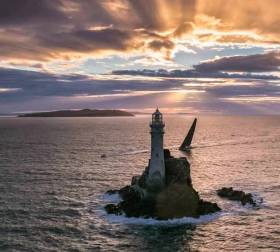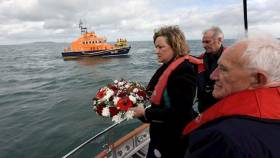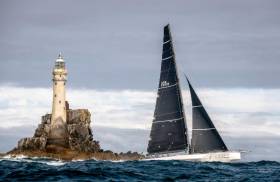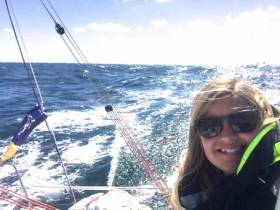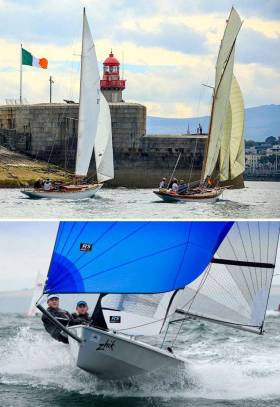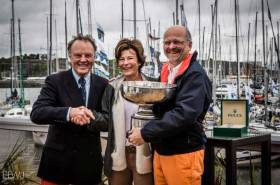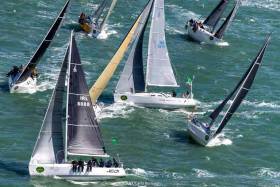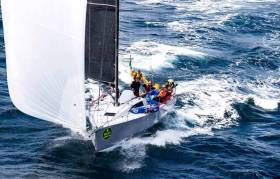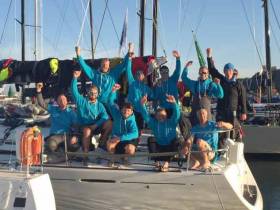Displaying items by tag: Fastnet
New Fastnet Course to Finish at Cherbourg – a Coup d’etat & a Fait Accompli?
Well, there’s been something in the air for long enough about the future of the Rolex Fastnet Race writes W M Nixon.
Back in September 2018, we were testing a few ideas about where it might go here
And on revisiting the column, we find that it has been getting hits ever since. Then the Plymouth Herald did a bit of speculation as reported by Afloat.ie’s MacDara Conroy, and there was indeed something in the wind, for as revealed today with the “sudden" announcement that Cherbourg is to be the finishing port in 2021 and 2023, we have – as the new "co-owners" of the race would put it – a fait accompli, a coup d’etat of very complete type (whatever that is in French, and whatever you’re having yourself.)
French boats have won something like three out of the last four Fastnet Races, and even though the most recent this year was won by the American Wizard, there were French boats dominant as usual in all other classes. They probably have increasingly proprietorial feelings towards the race. And with today’s bombshell definite news, the way is clear for making more of a song and dance about the new French finish port at this year’s Paris Boat Show, which starts in ten days' time. But that said, it’s still Ireland’s rock and always will be. So now that it’s apparent there’s serious new money floating around the Fastnet Race, maybe Cork County Council should be preparing an invoice for Cherbourg council, and no April Fool either.
Fastnet 1979 Irish Survivors' Reunion Remembers Those Who Died & Pays Tribute to Rescue Agencies
When an “explosion of a storm” tore its way through the Fastnet yacht race off the Irish coast 40 years ago, there were those among the survivors who could not speak about the experience for years writes Lorna Siggins
However, over 100 sailors, rescuers and relatives of Fastnet ’79 competitors were not quite so lost for words in Howth Yacht Club, north Dublin yesterday as they gathered to remember the event.
The first full reunion of crews among Irish yachts involved in the race began with a wreath-laying at sea by the RNLI Howth lifeboat in memory of those who died.
Although the official death toll in the yacht race was initially stated at 15, and then 19, the actual figure is 21, according to Commodore John Kavanagh, now retired from the Naval Service, who was in command of the LÉ Deirdre patrol ship during the rescue effort.
Cdr Kavanagh recalled how two of the fatalities were a young couple who had joined a spectator boat, Buck’s Fizz, in Cowes shortly before the Fastnet race start from the southern English coast on August 11th, 1979.
“When we picked up that upturned catamaran, all four crew had lost their lives – but the bodies of the young couple were never actually found,” he said.
“There will never be a storm like that again – only because now we rely on sophisticated forecasting and real-time information about its progress,” Cdr Kavanagh observed.
Drawing on photographs taken by one of his ship’s crew, he recalled the LÉ Deirdre’s role in locating yachts, after the ship’s barograph measuring atmospheric pressure fell by 25 millibars in the space of ten hours.
RNLI Baltimore lifeboat coxswain Kieran Cotter, who was a crew member out on rescues for up to 75 hours in 60-knot winds, and lightkeeper Gerald Butler, who had been stationed on the Fastnet, were among the guests at the event organised by Kevin Burke, Kieran Jameson and Brian Lennon.
Kevin Burke was on board the Rapparee, a nine-metre (30 ft) Shamrock, designed by Ron Holland, which rolled over to 180 degrees at one point – and eventually made it into Dunmore East, Co Waterford.
His fellow crew, navigator John Marrow and Enda O’Coineen, recalled how they managed to communicate with an RAF helicopter by Motorola hand-held radio, and only knew the full extent of the disaster when the pilot informed them he had “bodies to pick up”.
The 18 Irish-flagged 1979 Fastnet yachts represented yesterday included crews from Cork vessels Golden Apple of the Sun owned by the late Hugh Coveney, Wild Goose, Moonduster, Irish Mist 111, Tom O’Shanter and Clayton Love Junior's Silver Apple of the Moon.
Michael O’Leary, who had been on Golden Leigh, was among crews from ten Dublin yachts at the event, while Donal McClement, RAF search and rescue pilot sailing on Black Arrow and Sally O’Leary, crew on the British-flagged yacht Yeoman XXI, also attended.
Journalist Winkie Nixon paid tribute to the rescue agencies, including RNLI lifeboats from the Scilly Isles and Penlee in Britain, from Baltimore, Ballycotton and Courtmacsherry in Co Cork and Dunmore East, Co Waterford .
They spent up to 75 hours at sea in what was described as the largest ever peace-time maritime rescue operation, along with the Naval Service, the Royal Navy, Dutch Navy, US Navy and HM Coastguard.
“When someone saves your life, you can never repay them,” Mr Nixon observed, quoting from the biography of Ron Holland who, he said, had written the best account of those four days.
The 1979 Fastnet race was to have been the climax of an Admiral’s Cup series that Ireland was tipped to win, and there were almost 3,000 recreational sailors at sea, with minimal safety equipment and few VHF radios on some spectator yachts.
They were scattered between the Scilly isles and the Fastnet – some competing and many following the 605 nautical mile course from the Isle of Wight and back to Plymouth – when a French forecast gave the first indication of the gathering maelstrom.
American Owner George David, skipper of Rambler 88 the monohull line Fastnet Race winner has again paid tribute to the RNLI Lifeboat crew in Baltimore West Cork who rescued him after he capsized at the rock eight years ago. "We know those people pretty well. We've been back to Baltimore four or five times since", David said ashore today as he praised the sensational 2011 rescue as Afloat reported at the time here.
David won monohull line honours this morning, after crossing the Plymouth finish line at 09:55:02. David and his all-star crew were delighted to have beaten their rivals on the 100-footer SHK Scallywag to the punch.
"Passing the Rock was an emotional moment for David"
For a while it looked like breaking the outright monohull race record was on the cards, especially after Rambler 88 set a new record from Cowes to the Fastnet Rock, George David beating his own record by 88 minutes, which he set on Rambler 100 back in 2011. The race back across the Celtic Sea towards the Scilly Isles was also very quick with straight-line sailing at speeds of around 20 knots. But it was the final run into Plymouth from the Scillies that put paid to any race record hopes. In the end, Rambler 88 finished in a time of 1d 19h 55m 2s, 1 hour and 16 minutes off the record set by the Volvo Open 70 Abu Dhabi Ocean Racing in 2011.
Not that George David was complaining. This was his fifth assault on the Rolex Fastnet Race and he has succeeded in repeating his line honours victory from two years ago. "We're delighted to have that outcome. It was a contest this year because we had the big hundred footer Scallywag and they had some, should we say, strong statements ahead of the race about how good they were! And so we were especially motivated to get here 10 or 12 miles ahead of them, which we did. And we were in heavy competition right from the start."
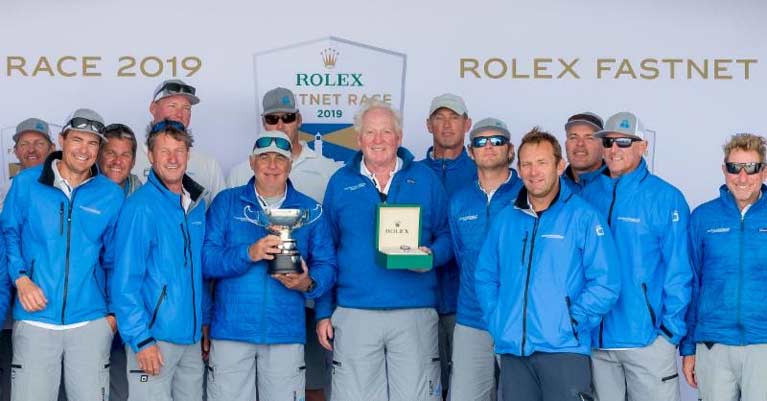 George David (centre) and team on Rambler 88 - Rodney Ardern, Scott Beavis, Curtis Blewett, Brad Butterworth, Antonio Cuervas Mons, Rodney Daniel, Simon Daubney, Jan Dekker, Brian Giorgio, Jerry Kirby, Tony Langley, Will McCarthy, Mark Newbrook, Dean Phipps, Aaron Reynolds-Lovegrove, Julian Salter, Joca Signorini, Peter van Niekerk, Stuart Wilson © Rolex/Carlo Borlenghi
George David (centre) and team on Rambler 88 - Rodney Ardern, Scott Beavis, Curtis Blewett, Brad Butterworth, Antonio Cuervas Mons, Rodney Daniel, Simon Daubney, Jan Dekker, Brian Giorgio, Jerry Kirby, Tony Langley, Will McCarthy, Mark Newbrook, Dean Phipps, Aaron Reynolds-Lovegrove, Julian Salter, Joca Signorini, Peter van Niekerk, Stuart Wilson © Rolex/Carlo Borlenghi
Passing the Rock was an emotional moment for David, with Rambler 88 encountering very similar, rough conditions that had befallen the ill-fated Rambler 100 there eight years ago. As the boat reached the Rock this time, David had no idea that he'd just set a new record to the Fastnet lighthouse. "I had some other things on my mind - from 2011 when we were up there in comparable conditions, 25-30 knots in really lumpy seas a few miles west of the Rock. The keel came off, the boat rolled over and that was the end of that. So we have some special memories. At least I did personally.
"My wife Wendy wasn't on the boat this time. She was in 2011 and she and I spent three hours in the Celtic Sea courtesy of that little issue. Baltimore lifeboat was there yesterday, to meet and greet and wave and say hello. We know those people pretty well. We've been back to Baltimore four or five times since." David paid tribute to everyone who helped in that rescue operation and remains grateful to this day for an outcome that could have been a lot, lot worse.
Once past the Fastnet, the New Yorker's mind turned towards the possibility of breaking the race record. It was looking good until the final run in from the Scillies. "Our route plan at the rock was we would finish at six or seven this morning, which would have been ahead of the record. The problem was we turned the corner at the Scillies and came down the Channel and it was VMG the whole way. So we sailed probably an extra 40 or 50 miles. And that extra distance sailed added maybe another two or three hours on to our time."
Rambler 88's navigator, Jules Salter, had just completed his 14th consecutive Fastnet Race but said this was one of the best. "That was a great run on board a fantastic boat with a really good bunch of guys. It would have been great to have beaten the record, but at least I've still got the record because I was on board Abu Dhabi in 2011. We'll have to come back for another go."
SHK Scallywag finished just 27 minutes after Rambler 88. "It was a very close, exciting race," said owner Seng Huang Lee. "We had a little bit of everything - fine weather, rough sea and a squall just before we rounded the Rock. But these were the conditions that Rambler was designed for, so congratulations to them."
The great George David’s Rambler 88 – holder of the Round Ireland monohull record – finished the Rolex Fastnet Race at 0955 this morning to take mono-hull line honours, but the final run into Plymouth from the Scillies put paid to a new mono-hull race record hopes as Rambler 88 finished in a time of 1d 19h 55m 2s, 1 hour and 16 minutes off the record set by the Volvo Open 70 Abu Dhabi Ocean Racing in 2011 writes W M Nixon.
Rambler 88 had already established a new outward leg record when she cleared the Fastnet Rock at 1645 hrs yesterday evening, but the ability to maintain high speeds all the way to the finish – was frustrated by the winds easing towards Plymouth and drawing from dead astern, necessitating long tacks to lee.
Another of the big boats which has done exceptionally well is also American, David & Peter Askew’s Volvo 70 Wizard skippered by Charlie Enright, which finished at 11.37 to put her in a strong Corrected Time Overal Lead. Theoretically is can be beaten by smaller boats having a very fast unhampered return from the Fastnet Rock, but Wizard has been sitting in the overall lead for more than half of the race, and her time really will take some beating.
In fact, at the moment big boats dominate the Corrected Time placing, and 8th overall and 7th in IRC Zero is Bryon Ekhart’s Mini Maxi Lucky – currently off the Lizard running for the finish at 17 knots – whose crew includes peripatetic pro sailor Shane Diviney from Howth.
Ten miles ahead of Lucky is the leading IMOCA 60 Charal (Jeremie Beyou) shaping up for what could be quite a close finish among the leaders of the remarkably 20-stong IMOCA 60 class, as at least three other boats are within striking distance, and as yesterday’s afternoon’s 59 (or was it 58) seconds last-gasp victory by Gitana XVII/Maxi Edonde de Rothschild over Macif showed, you’re not there until you’re there.
Once the major razzmatazz of the IMOCA 60s has been cleared from centre stage, we can turn to complete concentration on the real Rolex Fastnet Race, the Fastnet Race of club crews campaigning with longtime shipmates in able little boats which won’t grab headlines, but they do the business in style.
As we pointed out in our very first Fastnet Race update, few do it better than the boats built in Lorient by Jean-Pierre Kelbert to designs by Jacques Valeur into which JPK himself makes a very definite input. At the moment as they slice their way towards the Fastnet on an increasingly bumpy sea – for the sou’wester has been vigorous for some time now – their top boat, Gery Trentesaux’s JPK 11.80, has just four miles still to sail to the Fastnet and is leading IRC 2 and IRC 2A but is now 22nd in IRC overall, having at one stage got up to 14th overall.
The second string to the JPK bow is Eric Mordret’s JPK 10.80 Dream Pearls, she is first in IRC and IRC 3A, but in this big boat race she’s back in 37th overall, while the third part of the JPK top trio is Noel Racine’s relative veteran, the JPK 10.10 Foggy Dew, which leads IRC4 and IRC 4A, but is 45th overall.
In addition, the new JPK 10.30 Leon with JPK himself onboard is second in IRC 3 and leading IRC 3B while rating 38th overall in IRC, so the word is that, size-for-size in a varied and at times unexpectedly rugged race such as this, the JPK range provides some superb all-rounders.
Unfortunately, Ireland’s definitive JPK 10.80, Dingle race winner Paul O’Higgins Rockabill VI, is currently in Schull in serious crew training for Calves Week 2019 which starts tomorrow, so for Irish hopes in the Fastnet Race 2019, we have to keep looking elsewhere.
Yet who would have though of Tom Dolan as a shrinking violet? Admittedly he has now committed himself so totally to the Beneteau Figaro circus that there may well be some friction if he shines in boats of another marque, but Afloat.ie can reveal that the Mighty Meath Mariner is very much involved in this race, but it so happens that he’s racing a Jeanneau SunFast 3600 in the two-handed division.
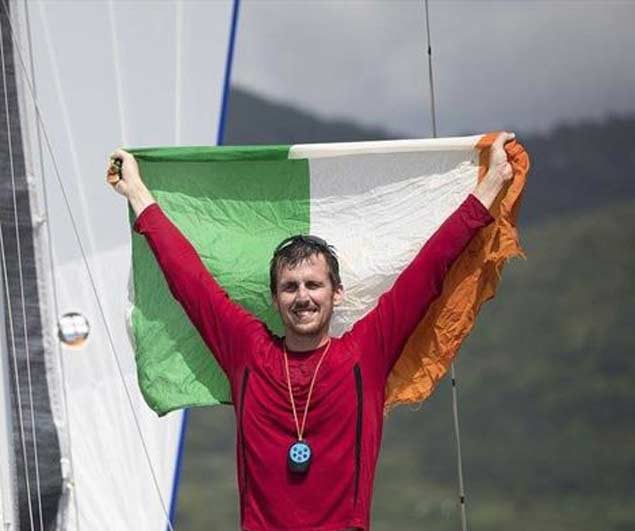 Tom Dolan is successfully flying the flag for Ireland in the Fastnet Race 2019 Two-Handed division
Tom Dolan is successfully flying the flag for Ireland in the Fastnet Race 2019 Two-Handed division
Officially the boat is called One Way and she’s owned and skippered by Polish sailor Janusz Madey. But Ingredient X on board is one Thomas Dolan, and as they’re lying fifth in the large Two-Handed Division and fifth in IRC 3 and 4th in IRC 3A, so they’re going good which suggests we’re looking at a very effective co-skipper arrangement.
Meanwhile, Ireland’s previous star in the SunFast 3600 firmament, 2017 Sailor of the year Conor Fogerty of Howth, has not been having a happy race with Raw, the only one of the new foiling Beneteau Figaro 3s in the entire feet. Conditions have not been good for a smaller foiling boat, and Raw – despite a crew of all the talents – maybe managing a respectable 8.3 knots at the moment as she bashes toward The Rock, but she’s 37th in IRC 1, 21st in IRC B, and 156th in IRC overall – as the old saying would have it, it’s taking a helluva lot of boats to beat her.
Other hopes-at-one-time have also faded – Conor Doyle’s Xp 50 Freya made have led Class 1 briefly on Saturday night, but faced with the prospect of a veering wind as she squared up to the Scillies-Fastnet Rock leg, she elected to take her punishment early and go west of the TSS to the west of the Scillies, and though she’s now about 20 miles from the Fastnet Rock, her placing of 22nd in IRC 1 makes it a moot point of whether or not that rather extreme tactic paid.
But meanwhile Kenneth Rumball and Barry Hurley in the Ker 40 Keronimo now have the rock well astern, and are making a steady 13.6 knots towards the Bishop, still at fifth in IRC 1, and fourth in IRC1A. They’re definitely the Steady Eddies of the Irish presence in Fastnet 2019.
Race Tracker & Leaderboard here
Irish International Offshore Racing Is On A New High – How to Join?
In an exceptional week for Irish international offshore sailors, the Michael Boyd-skippered Lisa has been confirmed as both the RORC Points Champion and the Boat of the Year, while the Damian Foxall-crewed Vestas 11th Hour Racing has emerged as the convincing winner of the first stage of the Volvo Ocean Race 2017-18. And at home, Nicholas “Nin” O’Leary has appeared with a newly-acquired IMOCA 60, his own first command in this extreme class for which the Vendee Globe Non-stop Solo Round the World Race is the ultimate objective. W M Nixon takes a look at a high-powered scene which has many facets, and outlines how one Mayo sailor hopes to progress her own career in it.
International offshore racing is a universe unto itself, a place where superhuman skills have to be allied with exceptional organisational ability. Needless to say, the presence of straightforward courage is taken as read. For many of us as we consider the year’s past achievements, which moved up a gear early in the season when Conor Fogerty won the prized Gipsy Moth Trophy in the Single-handed Transatlantic Race, it is at a level which we can barely grasp, let alone expect to emulate.
So how can you hope to get a foot on the ladder? Well, it depends on whether you want offshore racing to be your recreational sport, or perhaps even just one of several personal sports in a busy life with a day job, or whether you want it to be a fulltime career.
Irish National Sailing & Powerboat School
Here on Sailing on Saturday we have twice interviewed skippers who have won the Roger Justice Trophy (the sailing schools’ prize) for Ireland in the Fastnet Race, Ronan O Siochru of Irish Offshore Sailing with the Sunfast 37 Desert Star in 2015, and Kenneth Rumball of the Irish National Sailing & Powerboat School with the J/109 Jedi this year. Both gave considerable insight into what is involved in learning and training towards an acceptable level of competence with genuine race-winning potential.
 Ronan O Siochru (third from right) with his crew from Irish Offshore Sailing after their success in the 2015 Rolex Fastnet Race
Ronan O Siochru (third from right) with his crew from Irish Offshore Sailing after their success in the 2015 Rolex Fastnet Race
 Another successful Irish challenge for the Roger Justice Trophy gets under way – the Irish National Sailing School’s J/109 Jedi (left foreground) at the start of the Rolex Fastnet Race 2017
Another successful Irish challenge for the Roger Justice Trophy gets under way – the Irish National Sailing School’s J/109 Jedi (left foreground) at the start of the Rolex Fastnet Race 2017
Another route was shown by Michael Boyd skippering Lisa in the complete RORC programme. As Commodore of the club, he gives priority to encouraging youth sailors with the RORC into Lisa’s crew, and with his inspirational leadership, they blossom into capable offshore seamen. He was developing this way of doing things in 2016, when Lisa enabled him to be the top-placed Irish skipper in the Round Ireland Race, and by 2017 it had become so much a part of the boat’s campaigning that they could arguably have entered for the Roger Justice Trophy in the Fastnet Race themselves.
Royal Ocean Racing Club
However, the Royal Ocean Racing Club is a substantial and long-established organisation, with a large international membership and professional headquarters staff, thus the structures to channel would-be offshore sailors into the sport can function smoothly. And in the end, the “graduates” will tend to see themselves as Corinthians rather than fulltime sailors.
 Successful administrators. Theo Phelan (left) organizer of the Volvo Round Ireland Race, with RORC Commodore Michael Boyd after the latter had finished the race at Wicklow as top-placed Irish skipper in 2016
Successful administrators. Theo Phelan (left) organizer of the Volvo Round Ireland Race, with RORC Commodore Michael Boyd after the latter had finished the race at Wicklow as top-placed Irish skipper in 2016
Damian Foxall
But for hopeful young Irish sailors seeking to get into the fulltime offshore racing professional world, the promised land is France. That certainly was the route taken by Damian Foxall, who worked his way through France’s Figaro solo and two-handed scene and on into the exalted heights of Volvo racing, the Barcelona World Race, and massive multi-hull global record challenges, until now at the age of 48, with much achieved and busier than ever, his advice as dispensed on this week's Afloat.ie podcast is pure gold.
To succeed, Foxall says that basically you’ve to be a one-person business corporation. It’s not remotely enough just to be an ace helm, and handy on the foredeck with it. You have to truly know yourself, and realize the depths of dedication and sacrifice required, but at the same time you have to know everything – but everything - about boats, their rigs, their sails and the suppliers – and that’s before you even think about meteorology and strategy and tactics and effective handling of the media plus a zillion other things. And don’t forget to be an extremely efficient accountant too……
It may all seem a very long way from the dream of speeding across the blue ocean on a sunny day without a care in the world, with the winning line in sight and the rest of the fleet tucked in comfortably astern. But that’s the harsh reality which has been the lot of an extraordinary range of Irish sailing characters.
In the offshore sailing jungle angled towards France, you’re tangling with big beasts afloat and ashore, and the politics of it all are fraught. When we mention key names, it is merely a list, for it’s such a fluid world that link-ups are changing and being taken in completely new directions all the time. If you don’t know who we’re talking about in mentioning Enda O’Coineen, Marcus Hutchinson, Tom Dolan, David Kenefick, Stewart Hosford, Damian Foxall and Nin O’Leary – to name only seven – then you’re blissfully unaware of the rarefied heights where only the bravest will tread.
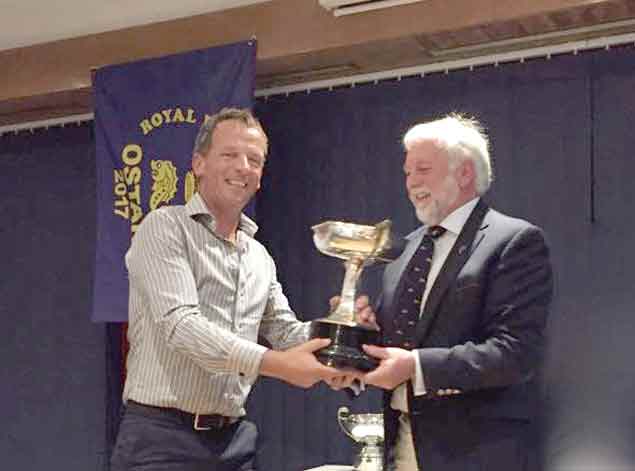 Conor Fogerty finally receives the Gipsy Moth Trophy at the Royal Western Yacht Club in Plymouth last weekend from RWYC Commodore Charlie Thompson
Conor Fogerty finally receives the Gipsy Moth Trophy at the Royal Western Yacht Club in Plymouth last weekend from RWYC Commodore Charlie Thompson
Conor Fogerty
Somewhere in an outer orbit is the incredible Conor Fogerty, winner in June of the roughest Single-handed Transatlantic Race ever with his Sunfast 3600 Bam!. Fogerty is keeping his longterm cards very close to his chest, but for now he has recently sailed Bam! from the OSTAR finish port of Newport Rhode Island down to Antigua for the RORC Caribbean 600 in February. He’d a class win in it in 2016, and he has a dream crew pencilled in for next February’s race, a mixture of fulltime and top Corinthian with David Kenefick, Tom Dolan, Simon Knowles and Paddy Gregory going into the mix.
With the Gipsy Moth trophy collected at a convivial awards ceremony in the Royal Western Yacht Club in Plymouth last weekend, the re-location of Bam! back to the Caribbean has everything set up for a last hurrah with the successful Sunfast 3600 in the Caribbean 600, as Fogerty is another sailor keen for the really serious stuff, and is definitely in orbit round the IMOCA 60s.
But meanwhile, with a young family, he likes to have a handy little “cruising” boat at home in Howth. So just recently he bought the ultimate Ron Holland-designed 30ft Shamrock, Silver Shamrock herself, with which Harold Cudmore won the World Championship in 1976. She has been beautifully up-graded by Stewart Greenfield at Cowes, and as Conor’s partner is Suzanne Ennis whose sister Steph Ennis with Windsor Laudan successfully campaign the classic Club Shamrock Demelza (once raced for several seasons in Cork by a very young Mark Mansfield), then clearly with the Ennis approval of Shamrocks, acquiring Silver Shamrock was a no-brainer for someone who wants to maintain domestic harmony at home while pursuing grand designs on the high seas.
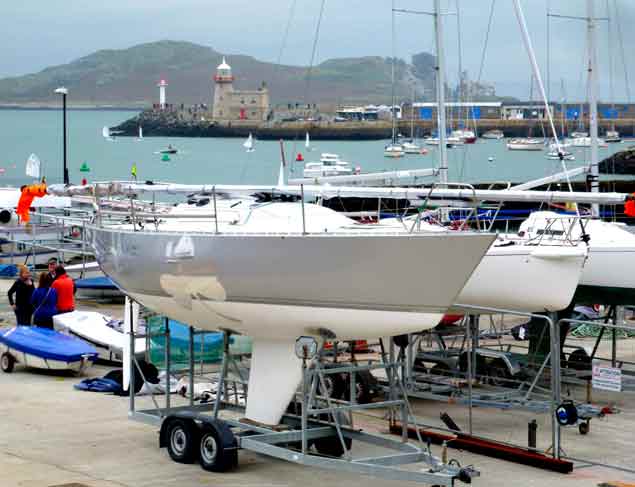 The Ron Holland-designed Silver Shamrock, Half Ton World Champion at Trieste in 1976 under Harold Cudmore’s command, has been brought to Howth “as a useful little family sailer” by Conor Fogerty. Photo W M Nixon
The Ron Holland-designed Silver Shamrock, Half Ton World Champion at Trieste in 1976 under Harold Cudmore’s command, has been brought to Howth “as a useful little family sailer” by Conor Fogerty. Photo W M Nixon
There are many starting points for getting started towards the serious offshore game. But at the moment all roads lead ultimately to France, even if those whose hearts are in Ireland hope to see this country providing more substantial shore bases where our our top sailors can be prepared to head forth for the big time events.
After all, if the Irish horse racing industry can provide tens of thousands of jobs for dedicated staff at every level, and ultimately produce the world’s greatest trainer in Aidan O’Brien with his record tally of major trophies won in every continent, then is it so unreasonable for these top offshore racing people we have listed to hope that Ireland – with immediate access to some of the best training water for offshore racing in the world – cannot do something similar for offshore sailing, albeit on a much more modest scale?
Joan Mulloy
Their dream would be to provide a structure whereby young sailors of exceptional promise can be fast-tracked to offshore racing achievement. The French system has produced the crop of young sailors in their 20s who are among the pace-setters in the Mini-Transat Class, most notably Erwan Le Draoulec who is only 21, while top woman star Clarisse Cremer was “only another competent solo sailor” until she underwent the intensive French training and coaching which turns good sailors into race winners, with the Fastnet Race 2017’s top results being dominated by French boats.
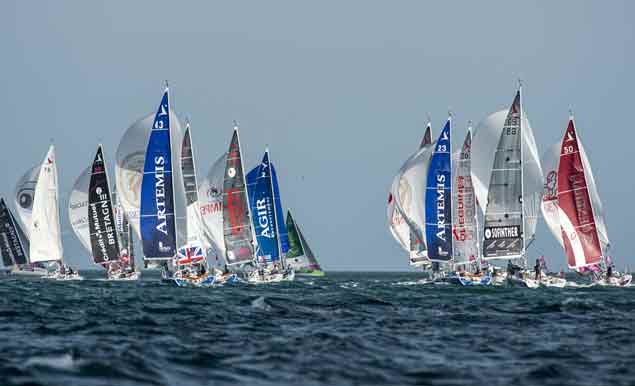 The 30ft Figaro Solo boats provide another introduction to top level offshore racing.
The 30ft Figaro Solo boats provide another introduction to top level offshore racing.
The larger boat used in the Figaro Solo fleet likewise provides French and international wannabees with another route to the top, and both classes and the organisations around them now draw in solo racing hopefuls from all over Europe. But the pace is hectic, the standards are rising every year, and this makes it all more of a challenge for a sailor from Mayo who interest in the offshore racing game has now become central to her way of life.
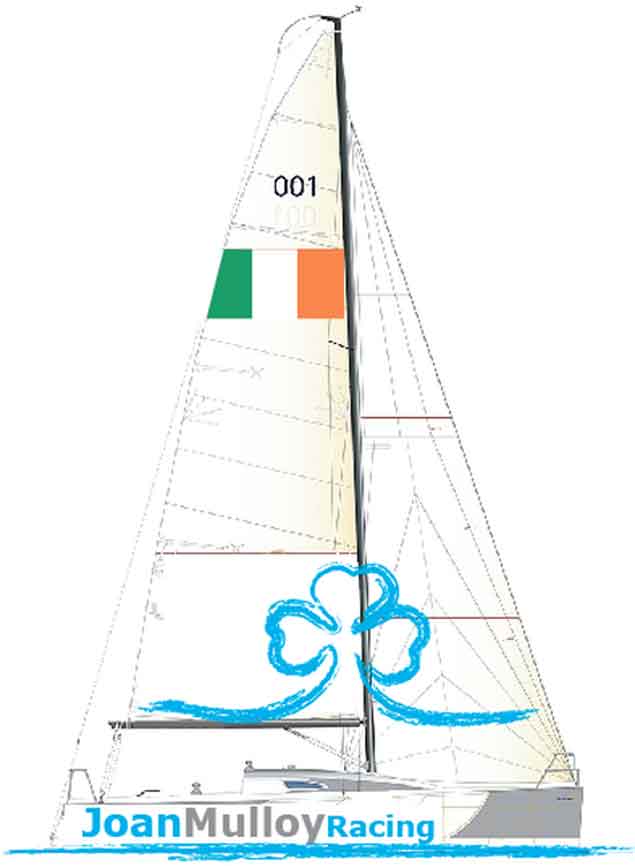 The logo location on the topsides of Joan Mulloy’s Figaro Solo will become available to any major sponsor
The logo location on the topsides of Joan Mulloy’s Figaro Solo will become available to any major sponsor
When you journey to Westport, you feel you’re headed for somewhere remote. But once you’re there in this handsome town at the head of majestic Clew Bay, it’s the rest of the world which seems remote, indeed almost irrelevant. Joan Mulloy is Westport and the Western Ocean through and through, from a marine-oriented seafood-harvesting background in which a history including Grace O’Malley may well make West Mayo the most naturally maritime part of Ireland.
She started her sailing with a Mirror Dinghy with Mayo Sailing Club at Rosmoney, and had her first Laser by the age of 14, though her first experience of dinghy sailing at national level was crewing a GP14 for Blair Stanaway, currently Commodore of MSC.
Yet at the same time she had acquired another interest which well matches sailing - at the age of 12, she started rock climbing. By her late teens this was her dominant interest, so much so that after getting her Leaving Cert, she took two gap years to base herself in Sheffield, working for an online outdoor equipment company, and availing of the wide opportunities provided in the north of England to be trained in rock climbing to the most demanding standards.
But having reached the ultimate heights in every sense, she realized just how much she missed the sea, and returned to the west of Ireland and NUI Galway, where she took an honours degree in Civil Engineering while becoming much involved in the sailing club. Even before going off for the rock climbing period, she’d realised her true sailing interest was in offshore racing, so she was a natural for the NUI Galway SC crew skippered by Cathal Clarke which raced the Reflex 38 Lynx in the 2012 Round Ireland Race, in which they were second for much of the time, and still were a good sixth at the finish.
 The Galway students with Lynx put Wicklow Head astern shortly after the start of the 2012 Round Ireland Race
The Galway students with Lynx put Wicklow Head astern shortly after the start of the 2012 Round Ireland Race
She worked for a while in civil engineering, but although the company was involved at the forefront of offshore engineering work, she found herself at a computer calculating the requirements for key structures. In some ways it was useful training for someone who would eventually be much involved with developing offshore racers, but more active involvement with the sea called, and she became a crewmember on the Volvo 70 Monster Project, logging thousands of offshore miles including Round Britain and Ireland, the Round Ireland of 2014, a Fastnet and a Middle Sea Race.
But in time, the draw was towards the Figaro Solo scene in France, and she became involved as a “preparateur”, one of the teams sorting the boats for the stars to race. The comparison with the horse racing industry is not inappropriate, and Joan Mulloy very much wanted to be a jockey rather than stable staff, so when a German owner offered her the loan of his well-used Figaro, No 77, she took it up. She based herself at Cowes, and she and her former skipper in the Round Ireland, Cathal Clarke, raced in the two-handed division in the Rolex Fastnet 2017, and came a respectable 17th in a class of sixty boats.
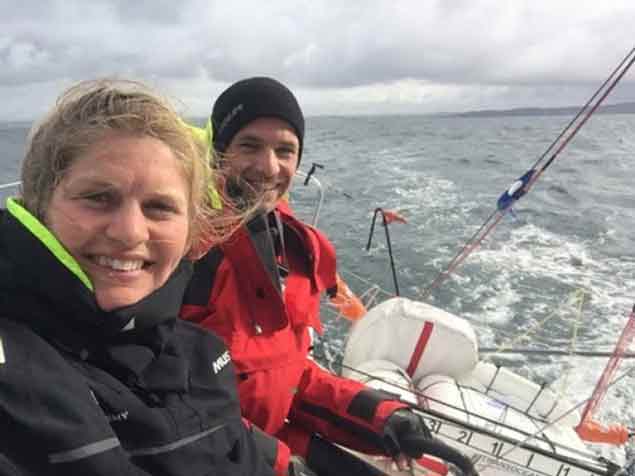 Joan Mulloy and Cathal Clarke racing Figaro 77 in the Rolex Fastnet 2017
Joan Mulloy and Cathal Clarke racing Figaro 77 in the Rolex Fastnet 2017
Enda O'Coineen
But before that, she’d met Enda O Coineen at the WIORA Championship in the Aran Islands in July, and he encouraged her to think that the setup in Ireland for people on her chosen career path was improving all the time, while in Cowes there was a distinct winding-down of activity. Whether it was the prospect of Brexit is anyone’s guess, but there’s no doubt that there’s a new buzz in Ireland to strengthen links with France and the Continent generally, and by September, Joan Mulloy had re-located her Figaro to Lorient, and returned to Ireland under the umbrella of Enda O’Coineen’s Team Ireland, while continuing to establish her own identity as a solo campaigner with Joan Mulloy Racing
It’s a busy time, with presentations to potential sponsors and then last night (Friday) she and Enda flew out to New Zealand to re-position the IMOCA 60 Kilcullen Voyager from Christchurch to Auckland as part of the preparation for the completion of his dismasting-interrupted solo Vendee Globe race, which will see him depart Auckland in January, complete a circuit of New Zealand to the point where he was dismasted at the very end of 2016, and then head on east for Cape Horn and the finish.
As for Joan Mulloy, her plan for January is to be right in the depths of solo sailing’s ultimate Boot Camp. She’s a very good sailor, she enjoys life, she’s great in boats, but as we pompously informed her at a meeting this week, she’s much too nice for her own good in top-level competitive sport.
She needs to be given a real racing edge. So the man to do that for her is the legendary coach/trainer/life-changer Tanguy Leglatin of Lorient. It’s said that a week at his Academy can transform a competent club racer into a potential world beater. Quite what it’s like providing a hothouse atmosphere in mid-January over a longer period we can only guess, but Joan Mulloy is determined to find out in the most thorough way possible. After all, it is Leglatin who brought forth the boy wonder Erwan Le Draoulec. Being under his tutelage is performance-transforming.
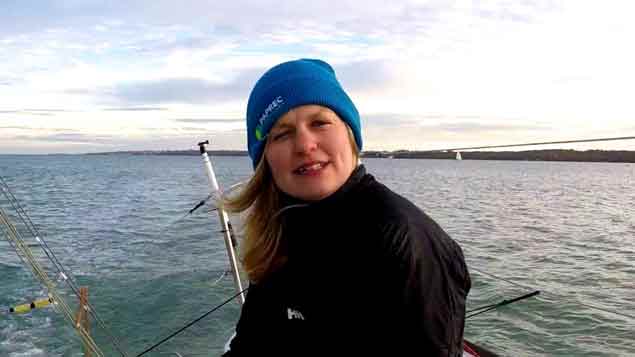 Winter training. January will provide the training and testing for Joan Mulloy
Winter training. January will provide the training and testing for Joan Mulloy
So we wish Joan Mulloy the very best of luck. For there’s something about this high-powered offshore scene that appeals in a special way. We were chatting yesterday with our man in Lisbon, who had in turn been talking with the manager of the Turn the Tide on Plastics crew. Apparently they’re a wonderful bunch to work with, as they all realize they’re on a near-vertical learning curve. And that healthy shared attitude is fully embraced by our own Silver Medallist, Annalise Murphy. She may be the Queen of Rio, but there are none of the usual prima donnas in the crew of Turn the ide on Plastics. Yet they’re all entranced by the special world of ultimate offshore racing. As is Joan Mulloy.
2017 – A Very Irish Sailing Season
While sailing is now a year-round interest, and for many a year-round activity too, the notion of a traditional season is natural for anyone who lives in Ireland. Admittedly, there are times when we seem to be experiencing the four annual climatic seasons in just one day. But this sense of a seasonal change, and the appropriate alterations in activity which accompany it, are in our genetic makeup. And though marinas and the Autumn Leagues which they facilitate have pushed the season’s end back to the October Bank Holiday Weekend, for many, that’s it. It’s finally time for boats to be rested and energies deployed in other ways. W M Nixon reflects on highlights of the year.
These times we live in, they tend to emphasise big events – celebrity happenings you might call them – and our perceptions of a season past may be skewed by how the major fixtures played through. But your true Irish sailing season has at its core the classic club programme from April to October, with its plethora of weekend and weekday evening events. If you want to sense the beating heart of our sailing, you have to take the pulse of this local and club scene.
We know it’s not for everyone. Some dinghy crews only emerge for major regional and national championships. But week in, week out, it’s the regular local sailing, from the smallest club right up to the majestic programme of Dublin Bay Sailing Club, which sets the tone for the majority of sailors.
 Week in, week out, Dublin Bay Sailing Club provides a comprehensive programme of local racing from the end of April until the end of September, and it has been successfully doing so since 1884. Here the club's Beneteau 31.7s, one of DBSC's largest one design keelboat fleets negotiate a weather mark at the class championships Photo David O’Brien/Afloat
Week in, week out, Dublin Bay Sailing Club provides a comprehensive programme of local racing from the end of April until the end of September, and it has been successfully doing so since 1884. Here the club's Beneteau 31.7s, one of DBSC's largest one design keelboat fleets negotiate a weather mark at the class championships Photo David O’Brien/Afloat
And for those who sailed regularly all through the time-honoured season, it has to be admitted that weatherwise, we experienced a very mixed bag. As we shall see, there were brief periods of good weather which blessed some events. But in any case, one dyed-in-the-wool cub sailor firmly told us that as far as he was concerned, it was a very good season.
“For sure, there was rain and wind,” he said. “But we need wind for sailing. If you get a long period of rain-free weather, the evenings are likely to be wind-free as well. Frankly I’d rather get a good race in rain than sit becalmed on a perfect summer’s evening. But as we’re an east coast club, we often get that east coast effect of Atlantic weather without Atlantic rain, which is ideal for club racing. By and large, it has been a good sailing season, and race management seems to be improving all the time. So 2017 is going to go down as a good year for club sailing, but only a very average year for sunshine”.
As for Irish sailing’s national structure, inevitably there’s a clashing of events. There is only a finite number of weekends available at peak season when different big ticket regattas and championships hope to be staged, but as well, each club and area quite rightly expect to bring prestigious fleets to its part of Ireland.
However, in 2017 there was increasing emphasis at official club level on making sailing fun again. We’d begun to take it too seriously, something reinforced by the grim years of the recession, and then the winning in 2016 of Annalise Murphy’s Silver Medal at the Olympics in Rio.
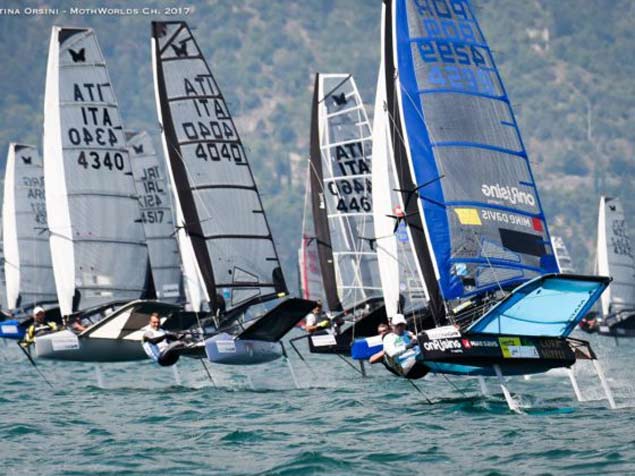 Olympic Silver Medallist Annalise Murphy led the way in signalling a change of mood for 2017 after the seriousness of her 2016 campaign towards success in Rio. In the early part of the season, she concentrated on the International Foiling Moth, and in this 223-strong fleet at the Worlds on Lake Garda in May, she became the Women’s World Champion. She is currently on a completely different direction for ten months on the Volvo Ocean Race as a crewmember on the One-Design Volvo Ocean 65 Turn the Tide on Plastic
Olympic Silver Medallist Annalise Murphy led the way in signalling a change of mood for 2017 after the seriousness of her 2016 campaign towards success in Rio. In the early part of the season, she concentrated on the International Foiling Moth, and in this 223-strong fleet at the Worlds on Lake Garda in May, she became the Women’s World Champion. She is currently on a completely different direction for ten months on the Volvo Ocean Race as a crewmember on the One-Design Volvo Ocean 65 Turn the Tide on Plastic
Of course the winning of Annalise’s medal was a matter for fun-filled celebration once it had happened, but the buildup to it was deadly serious, and that affected the tone of the national sailing mood in every area. But with the Medal in the bag, 2017 could reasonably expect to have a lighter mood, and this in turn helped us to adjust to an over-crowded programme, as crews could plan on a series of campaigns which balanced between serious events which provided proper championship results of national significance, and events which officially claimed to be providing everyone with a good time, even if some crews raced with deadly seriousness.
Either way, so much was going on that a review like this can only hope to give an impression of the season rather than a detailed analysis, but we’ll try to give it a comprehensible shape by listing the main events of Irish interest at home and abroad under either the “serious” or “fun” categorisations:
March/April: Intervarsity Championships – serious, UCD selected to represent Ireland
April: Irish Sailing Youth Pathway Nationals, Ballyholme - serious (and impressive), Ewan McMahon the star, Rush SC prominent in success
 The hyper-busy J/109 Mojito managed a hard-fought overall win in the ISORA Championship, successful participation in the Rolex Rastnet Race, and a second place in the Dun Laoghaire to Dingle Race.
The hyper-busy J/109 Mojito managed a hard-fought overall win in the ISORA Championship, successful participation in the Rolex Rastnet Race, and a second place in the Dun Laoghaire to Dingle Race.
April: Season-long ISORA Championship get under way, several venues – inevitably serious. In due course, J/109 Mojito (Peter Dunlop & Vicky Cox, Pwllheli SC) has very close overall win – despite taking time out to do the Fastnet
May: Scottish Series at Tarbert– serious, Pat Kelly’s J/109 Storm and Stephen Quinn’s J/97 Lambay Rules top their classes.
June: Howth Lambay Weekend – Fun
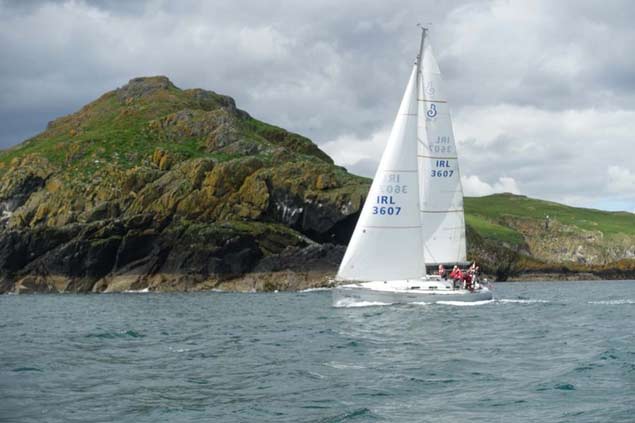 It could be a remote part of the West Coast, but Howth Yacht Club’s annual Lambay Race is a reminder that Ireland’s least-spoilt coastline is on an East Coast island. Photo courtesy HYC
It could be a remote part of the West Coast, but Howth Yacht Club’s annual Lambay Race is a reminder that Ireland’s least-spoilt coastline is on an East Coast island. Photo courtesy HYC
June: ICRA Nationals Royal Cork – probably the most serious of them all. John Maybury’s J/109 Joker 2 RIYC), Ross MacDonald’s X332 Equinox (HYC), and Paul Gibbons’ Anchor Challenge (RCYC) win the three main classes.
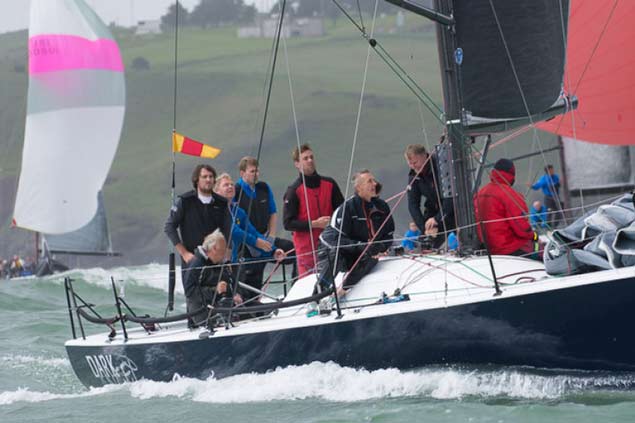 Rob O’Leary racing the Dubois 36 Dark Angel from South Wales to class success in the ICRA Nats at Crosshaven. Photo: Robert Bateman
Rob O’Leary racing the Dubois 36 Dark Angel from South Wales to class success in the ICRA Nats at Crosshaven. Photo: Robert Bateman
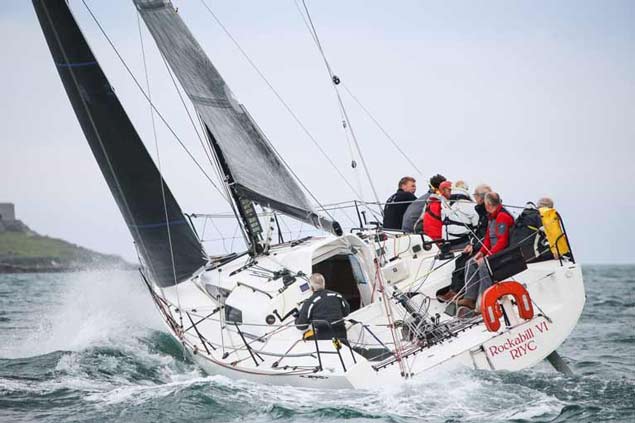 Paul O’Higgins’ JPK 10.80 Rockabill VI shortly after the start of the very tough Dun Laoghaire to Dingle Race, which she won, while a sister-ship Bogatyr was also winner of the likewise rough 608-mile Rolex Middle Sea Race in late October. This photo goes some way to revealing the reason for the JPK 10.80’s success – she is only 35ft LOA, yet you’d think you’re looking at a significantly larger boat. Photo: David O’Brien/Afloat.ie
Paul O’Higgins’ JPK 10.80 Rockabill VI shortly after the start of the very tough Dun Laoghaire to Dingle Race, which she won, while a sister-ship Bogatyr was also winner of the likewise rough 608-mile Rolex Middle Sea Race in late October. This photo goes some way to revealing the reason for the JPK 10.80’s success – she is only 35ft LOA, yet you’d think you’re looking at a significantly larger boat. Photo: David O’Brien/Afloat.ie
June: National YC Volvo Dun Laoghaire to Dingle Race – serious
June: Sovereign’s Cup at Kinsale – fun
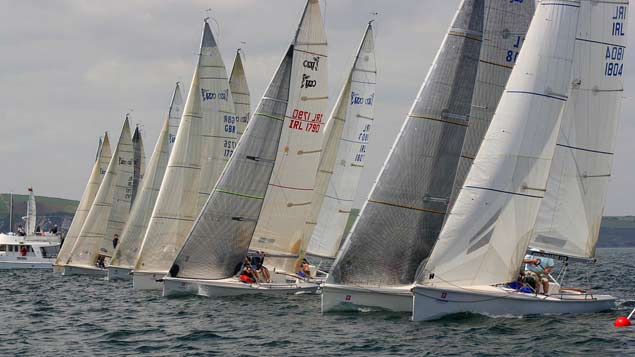 By maintaining its position as a standalone event, the Sovereign’s Cup at Kinsale can invite non-IRC classes to compete, and the 1720s responded with this keen turnout. The overall winner across all classes was adjudged to be Rob McConnell’s A35 Fool’s Gold from Dunmore East. Photo: Robert Bateman
By maintaining its position as a standalone event, the Sovereign’s Cup at Kinsale can invite non-IRC classes to compete, and the 1720s responded with this keen turnout. The overall winner across all classes was adjudged to be Rob McConnell’s A35 Fool’s Gold from Dunmore East. Photo: Robert Bateman
June: Dinghyfest at Royal Cork – brilliantly balanced mixture of serious & fun
July: Volvo Dun Laoghaire Regatta – superb, and fun
July: WIORA Championship at Aran Islands – unique
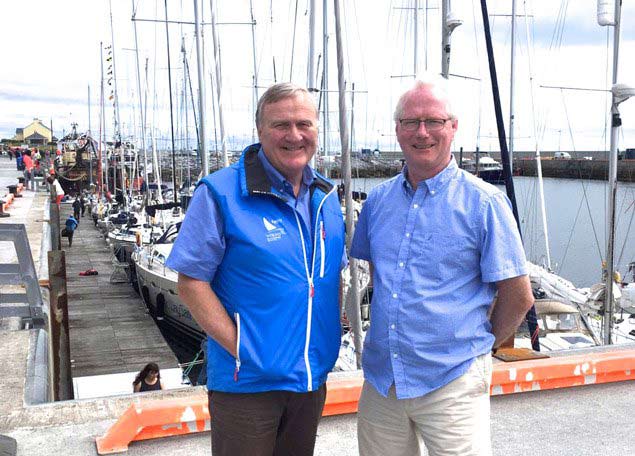 WIORA Nationals 2017 – and first time at the Aran Islands. Irish Sailing President Jack Roy (left) with WIORA organiser Cormac Mac Donncha. The popular Irish Sailing President seemed to have several doppelgangers, as that same evening he was present at the Opening Ceremony for the Volvo Dun Laoghaire Regatta, in which he also served for the entire four days as a Race Officer.
WIORA Nationals 2017 – and first time at the Aran Islands. Irish Sailing President Jack Roy (left) with WIORA organiser Cormac Mac Donncha. The popular Irish Sailing President seemed to have several doppelgangers, as that same evening he was present at the Opening Ceremony for the Volvo Dun Laoghaire Regatta, in which he also served for the entire four days as a Race Officer.
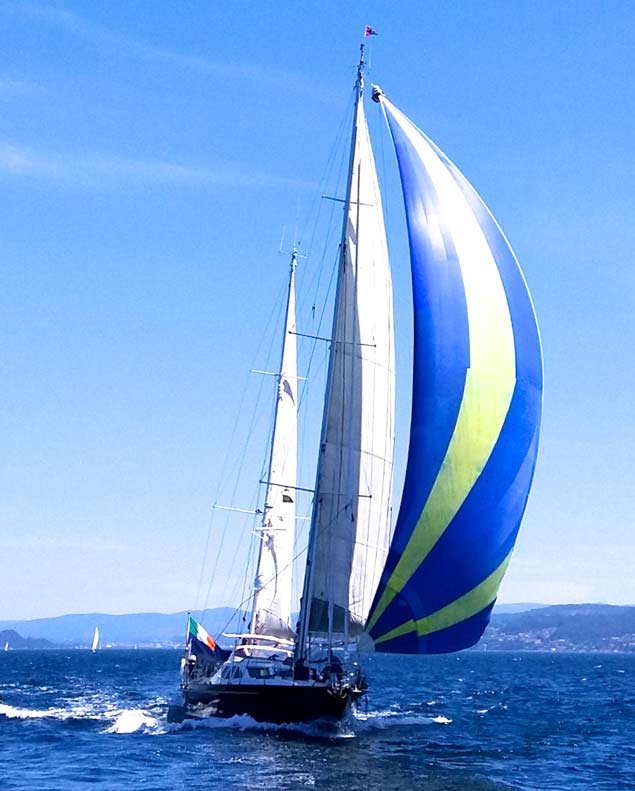 With more than sixty boats taking part, the Irish Cruising Club Rally in Northwest Spain was an outstanding success. This is Michael Holland’s 70ft 1993-built Dubois ketch Celtic Spirit – a veteran of Arctic and Antarctic cruising - making knots down the coast of Galicia. Photo: Trish Phelan
With more than sixty boats taking part, the Irish Cruising Club Rally in Northwest Spain was an outstanding success. This is Michael Holland’s 70ft 1993-built Dubois ketch Celtic Spirit – a veteran of Arctic and Antarctic cruising - making knots down the coast of Galicia. Photo: Trish Phelan
July: Irish Cruising Club Rally in Northwest Spain – seriously well organised, great fun to take part
July: Glandore Classics – fun, yet serious too
August: Rolex Fastnet Race from Cowes – serious
 Fastnet Rock astern for Jedi, the Irish National Sailing School’s successful J/109, which won class IRC 3B in the Fastnet Race, and also the Roger Justice Trophy for the top-placed Sailing School boat. Jedi is one of the 15-plus class of hotly-raced J/109s in Dun Laoghaire, whose annual championship was won by the Kelly family’s Storm from Rush SC and Howth, while the most successful boat in other events was John Maybury’s Joker 2.
Fastnet Rock astern for Jedi, the Irish National Sailing School’s successful J/109, which won class IRC 3B in the Fastnet Race, and also the Roger Justice Trophy for the top-placed Sailing School boat. Jedi is one of the 15-plus class of hotly-raced J/109s in Dun Laoghaire, whose annual championship was won by the Kelly family’s Storm from Rush SC and Howth, while the most successful boat in other events was John Maybury’s Joker 2.
August: Calves Week from Schull – prides itself on being a neat balance between fun and “quite serious racing”, and succeeds in being so.
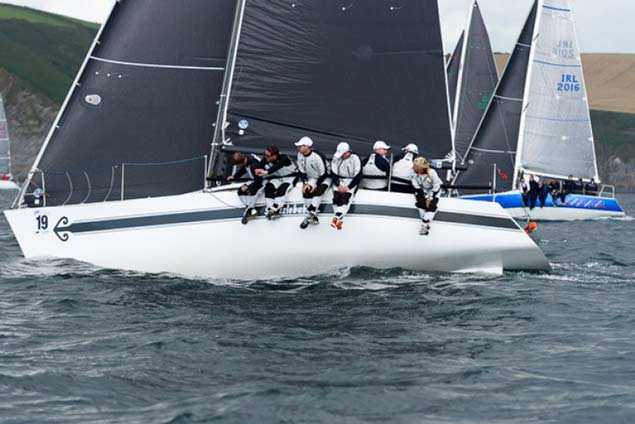 Everybody likes her, even if she beats them all. The characterful Swuzzlebubble racing to success in the Half Ton Classics at Kinsale. Photo: Robert Bateman
Everybody likes her, even if she beats them all. The characterful Swuzzlebubble racing to success in the Half Ton Classics at Kinsale. Photo: Robert Bateman
August: Half Ton World Classics at Kinsale: Supposedly serious, but in the ultimate lotus-eating venue and with such an extraordinary selection of boats, it couldn’t help but be fun. And everyone likes the slightly eccentric overall winner, the legendary Swuzzlebubble
August: Crinnui na mBad, Kinvara – traditional and fun
 The annual Crinnui na mBad at Kinvara in August may not have been favoured with good weather, but it was as popular as ever. This is one of the winners, John Flaherty’s Galway hooker Naomh Cailin, going out to race. Photo: Pierce Purcell
The annual Crinnui na mBad at Kinvara in August may not have been favoured with good weather, but it was as popular as ever. This is one of the winners, John Flaherty’s Galway hooker Naomh Cailin, going out to race. Photo: Pierce Purcell
August: Laser Nationals Royal Cork YC – serious
 RCYC Admiral John Roche, 2017 National Champion Finn Lynch (NYC) and Mark Whisker of sponsors Volvo at the prize-giving for the Volvo Laser Nationals at Crosshaven. Photo: Robert Bateman
RCYC Admiral John Roche, 2017 National Champion Finn Lynch (NYC) and Mark Whisker of sponsors Volvo at the prize-giving for the Volvo Laser Nationals at Crosshaven. Photo: Robert Bateman
September: Autumn League at Howth – fun event, but run with such serious efficiency that they’d a full programme completed after six weekends despite losing two days of racing to the late season’s poor weather.
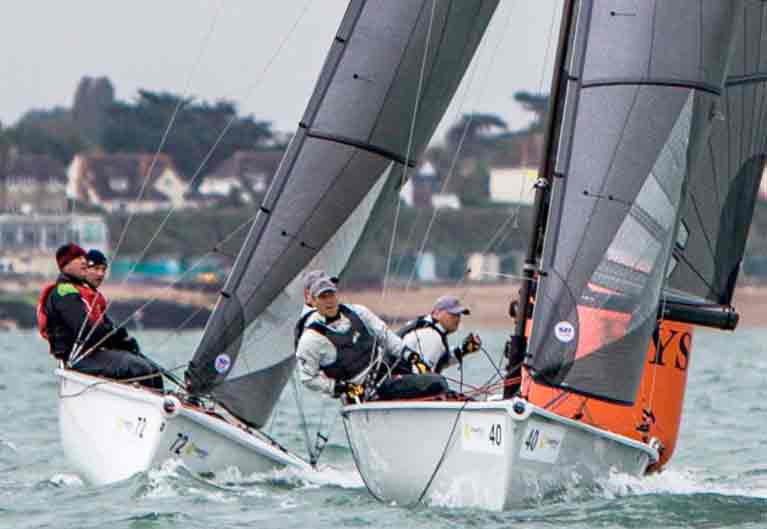 Royal St. George's Michael O'Connor, Davy Taylor and Ed Cook – SB20 'Corinthian' World Champions and Irish Champions
Royal St. George's Michael O'Connor, Davy Taylor and Ed Cook – SB20 'Corinthian' World Champions and Irish Champions
September: The SB 20 Nationals, incorporated into the first weekend of the Howth Autumn league as a three-day separate championship, had extra interest as it included recently-crowned SB 20 Corinthian World Champions Michael O’Connor, Davy Taylor and Edward Cook of Royal St George YC, who had won in the Worlds at Cowes. They added the Irish title to their 2017 trophy list.
October: Autumn League at Royal Cork - fun
October: Mini-Transat at La Rochelle – serious
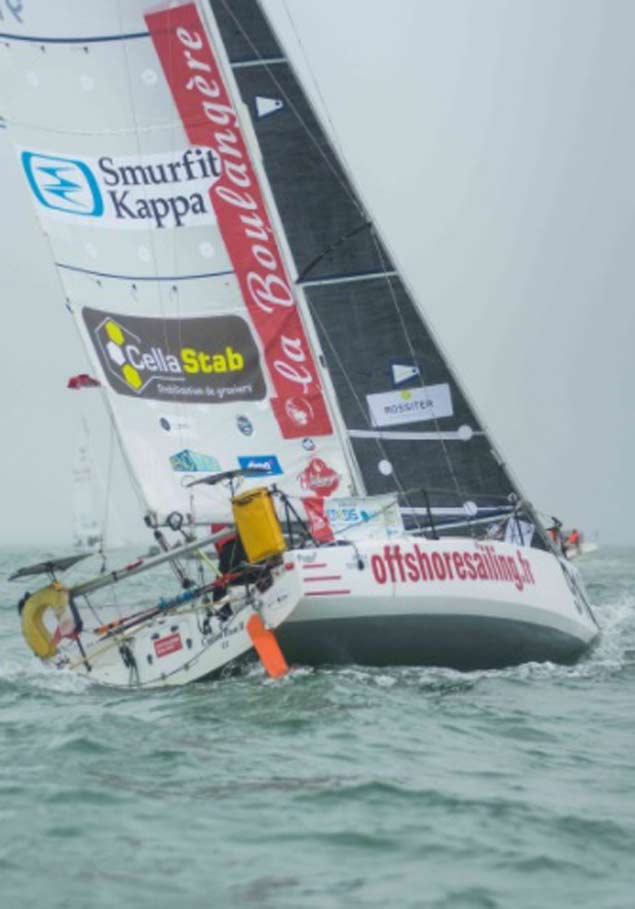 Ireland’s Tom Dolan in the first leg of the Mini-Transat 2017, 1,400 miles from La Rochelle to Las Palmas. He finished this stage 12th in a class of 55 boats The second Transatlantic stage starts on 1st November
Ireland’s Tom Dolan in the first leg of the Mini-Transat 2017, 1,400 miles from La Rochelle to Las Palmas. He finished this stage 12th in a class of 55 boats The second Transatlantic stage starts on 1st November
October: Junior All-Ireland at Schull – serious
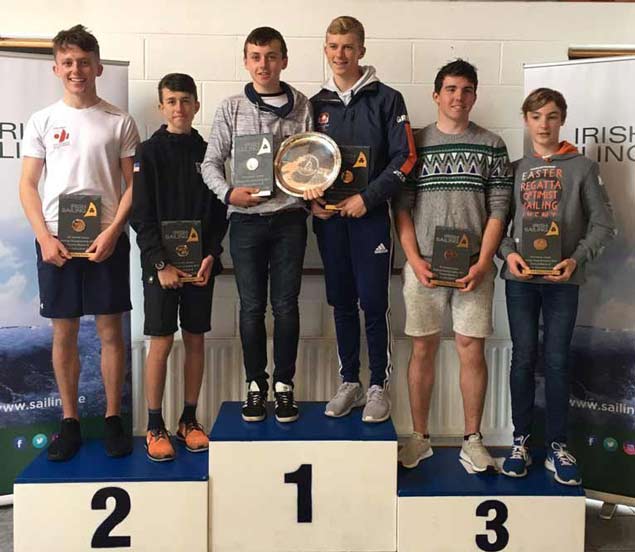 Junior All-Ireland winners on the podium. Kinsale YC’s champions Michael O'Suilleabhain and Michael Carroll, with second placed Rian Geraghty-McDonnell and Harry Durcan (RCYC) and Loghlen Rickard and Nathan Van Steenberge third. Photo: Robin Bateman
Junior All-Ireland winners on the podium. Kinsale YC’s champions Michael O'Suilleabhain and Michael Carroll, with second placed Rian Geraghty-McDonnell and Harry Durcan (RCYC) and Loghlen Rickard and Nathan Van Steenberge third. Photo: Robin Bateman
October: Senior All-Ireland Sailing Championship at Mullingar – serious and historic, as it is staged at one of the smallest, most rural clubs in the country, and raced in GP 14s.
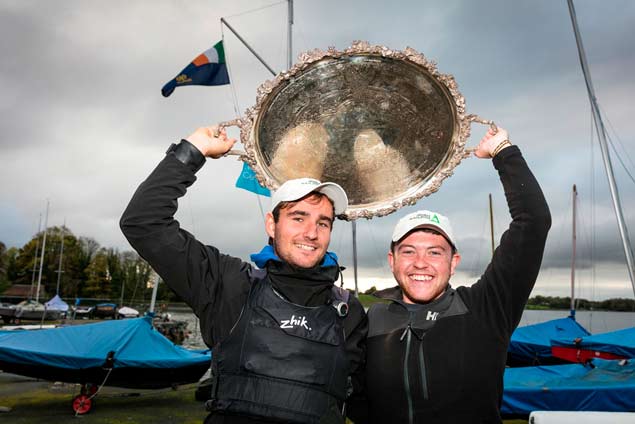 Fionn Lyden of Baltimore, All-Ireland Champion 2017, at Mullingar with the famous silver salver with crewmate Liam Manning of Schull. Photo: David Branigan/Sailing Ireland
Fionn Lyden of Baltimore, All-Ireland Champion 2017, at Mullingar with the famous silver salver with crewmate Liam Manning of Schull. Photo: David Branigan/Sailing Ireland
October: Student Yachting Worlds in Marseilles in France – serious. Ireland – a winner in times past –places fifth this time round.
October: Rolex Middle Sea Race from Malta – serious
October: Volvo Ocean Race from Alicante – serious
This fun/serious differentiation seems to have been supported by our wayward climate, which often managed to come up with good weather just when it was needed for the fun events, yet it achieved this in the midst of a generally very unsettled and often plain inclement summer.
The photos are all that is needed to show how this was so during 2017’s premier event, the Volvo Dun Laoghaire Regatta 2017 from July 6th to 9th. It wasn’t a sun-blasted regatta, but it wasn’t a wind-blasted one either – it was just a brief period of exceptionally pleasant warm weather with enough breeze for good racing , yet not too much wind to make it difficult to provide the in-harbour finishes which were introduced in special acknowledgement of the fact that they were also celebrating the Bicentenary of the massive work starting on the construction of this truly monumental and architecturally magnificent artificial port.
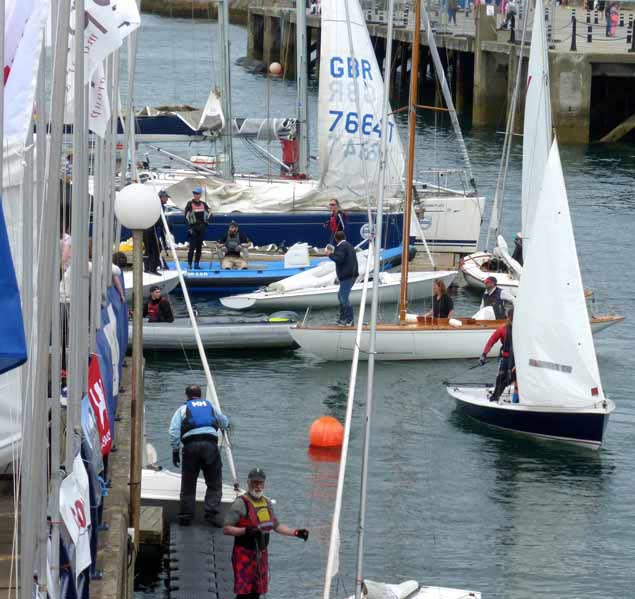 Piling them in – the good-humoured yet busy atmosphere off the National YC slipway after another day of racing in the Volvo Dun Laoghaire Regatta. Photo: W M Nixon
Piling them in – the good-humoured yet busy atmosphere off the National YC slipway after another day of racing in the Volvo Dun Laoghaire Regatta. Photo: W M Nixon
With 34 classes racing and boat numbers pushing towards the 500 mark, obviously it would have been totally inappropriate to try to include the ICRA Nats within it, as some have suggested. But even with such good conditions in its relaxed form, it could easily have got out of hand. However, with Organising Committee Chairman Tim Goodbody apparently yet always very quietly here, there and everywhere to ensure that all was running smoothly with a skillfully delegated team, it ran like clockwork to round out his two year stint in the top role with considerable style and success.
One noted visiting crew enthused that it was the best four days of sailing they’d ever had, and that was before they became aware that they’d won the ultimate trophy, the Kingstown 200 Cup, complete with a hundred guinea purse and a framed picture of the first regatta ever staged in what is now Dun Laoghaire, the Kingtown Regatta of 1828.
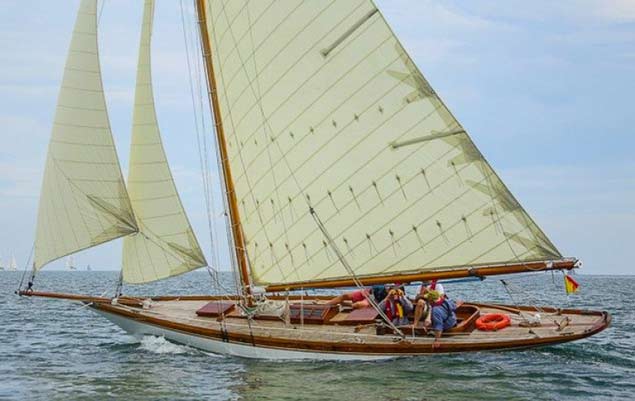 The sweetest boat in the fleet – Myfanwy from Wales - racing in the Volvo Dun Laoghaire Regatta. Photo: David O’Brien/Afloat.ie
The sweetest boat in the fleet – Myfanwy from Wales - racing in the Volvo Dun Laoghaire Regatta. Photo: David O’Brien/Afloat.ie
That was Rob Mason and his shipmates from Milford Haven with the classic 37ft Alexander Richardson-designed 1897-built gaff cutter Myfanwy, which Rob restored himself and sailed to Dun Laoghaire for the newly-introduced Classics Division, which was supposedly a one-off gesture to the Bicentenary.
But it worked so well that there’s talk of repeating it in 2019. Be that as it may, after the last race I was commiserating with the the Myfanwy team on their final placing, as I thought they’d sailed well enough to be comfortably on the podium, but Performance Echo decided others. Maybe they sailed too well. Yet far from being disappointed, they were on top of the world, and then when they went along to the huge prize-giving at the Royal St George, it was to hear to their complete surprise that the much-admired Myfanwy had been awarded the Kingstown 200 Cup and the prize purse and the historic picture……
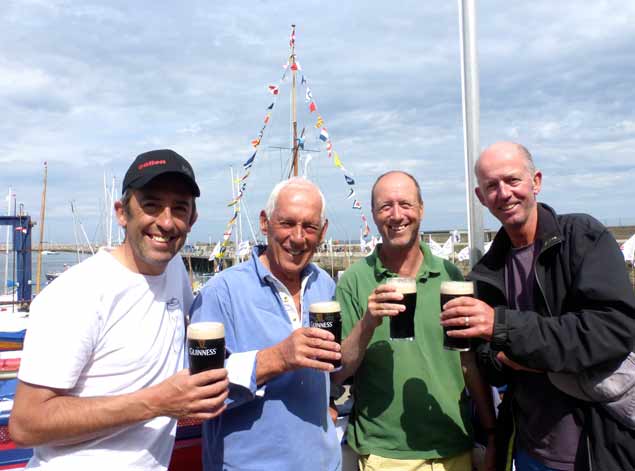 Before and after. Myfanwy’s crew celebrating “four days of the best sailing we’ve ever had” immediately after coming ashore at the conclusion of the final race in the Volvo Dun Laoghaire Regatta 2017. They are (left to right) Max Mason, his father Rob who restored Myfanwy, Andy Whitcher, and Gus Stott. The photo below shows them genuinely gobsmacked after finding they’d won the big trophy and its associated prizes. Photos W M Nixon and Gareth Craig/Fotosail
Before and after. Myfanwy’s crew celebrating “four days of the best sailing we’ve ever had” immediately after coming ashore at the conclusion of the final race in the Volvo Dun Laoghaire Regatta 2017. They are (left to right) Max Mason, his father Rob who restored Myfanwy, Andy Whitcher, and Gus Stott. The photo below shows them genuinely gobsmacked after finding they’d won the big trophy and its associated prizes. Photos W M Nixon and Gareth Craig/Fotosail

This classics success reflected a good year for the classic boats in Ireland, as six of the Howth Seventeens (1898) and a dozen of the Water Wags (1887 & 1900) made their way to the famous Sailing Week in the Morbihan in southern Brittany in May. Then at the end of July, the newest Howth 17s, Orla built in France for Ian Malcolm by the famous Skol ar Mor, arrived home, and in an epic effort in late August, in honour of Class President Hal Sisk, the continually reviving Water Wags managed their first turnout of more than thirty boats for their traditional Wednesday evening racing.
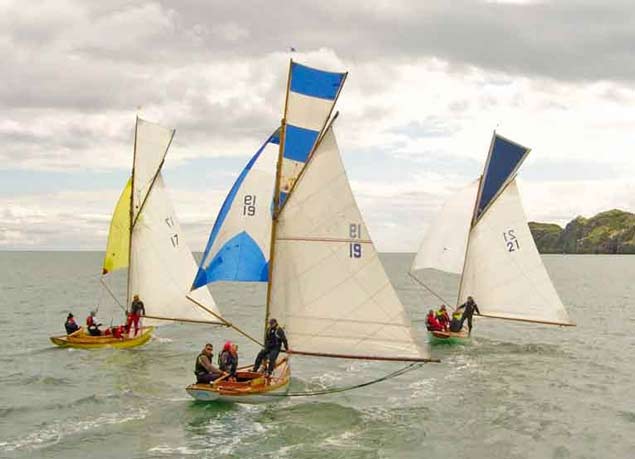 Howth Seventeens racing in their annual championship with Ireland’s Eye beyond – the new boat Orla (no 21) is on the right. Photo: Neil Murphy
Howth Seventeens racing in their annual championship with Ireland’s Eye beyond – the new boat Orla (no 21) is on the right. Photo: Neil Murphy
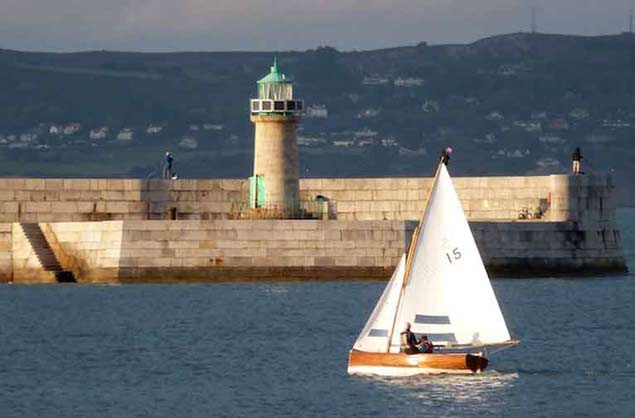 With a history going back to 1887, the Water Wags became an overnight success at the end of August when they finally managed a turnout of more than 30 boats. The clear winners were David & Sally MacFarlane with No 15 Mousmie, aged 107 years. Photo W M Nixon
With a history going back to 1887, the Water Wags became an overnight success at the end of August when they finally managed a turnout of more than 30 boats. The clear winners were David & Sally MacFarlane with No 15 Mousmie, aged 107 years. Photo W M Nixon
This has inevitably only been a skim across the events of 2017. An extraordinary season. Many hoped at the beginning of the year that it would see some relaxation after the intensity of the Olympic year, and while that may have been the overall mood, the achievements recorded above show that some sailors continued to take their own sailing very seriously indeed.
That is as it should be. But if I had to select a photo which captures the mood of 2017, the determination to make the best of it whatever the weather, then the Thomas Gautier image of Aoife Hopkins in devil-may-care mood, flying over a big sea off Douarnenez in Brittany on her way to winning the Laser Radial Under 21 European Championship, would undoubtedly be it. At that moment, Aoife was sailing for all of us.
 Sailing for all of us. Aoife Hopkins in devil-may-care style, on her way to winning the Laser Radial U-21 Euros at Douarnenez in July. Photo: Thomas Gautier
Sailing for all of us. Aoife Hopkins in devil-may-care style, on her way to winning the Laser Radial U-21 Euros at Douarnenez in July. Photo: Thomas Gautier
French Hat–Trick in Fastnet Race, Lann Ael 2 Wins Top Offshore Prize
For a third time running the Rolex Fastnet Race has been a story of French domination, Le Tricolor flying on this occasion from the top spot in IRC 1, 2, 3 and 4, the Class40 and IMOCA 60, the Two Handed and IRC Overall. Even the Chinese boat, Dongfeng Race Team, that won Volvo 65 competition had a largely French crew writes James Boyd. This left IRC Zero to American Ron O'Hanley's Cookson 50 Privateer, while, surprisingly, the only British class victory went to Tony Lawson's MOD 70 trimaran Concise 10, in the usually French-strong Multihull class.
Early on, the overall prize looked set to be a big boat affair with both the JV 115 Nikata and George David's maxi Rambler 88 leading until the run back from the Fastnet Rock favoured the medium-sized boats.
Ron O'Hanley's Privateer came close to making it a second Cookson 50 victory, a decade on from the overall win of Irishman Ger O'Rourke's Chieftain.
"This is a great race, an iconic race and we have had a great time even if we haven't won," said O'Hanley. "It was a fantastic start in Cowes - hard to see how you can get 400 boats out of the Solent at the same time! The weather conditions were good, not as light as it was last time and there was no drama coming out of the Solent."
As to where they did well, it was on the run back from the Rock said O'Hanley. "The big boats were leading, but then for a smaller boat to get into the lead was because of the very good conditions - tight reaching, we were planing most of the time and with the canting keel we could put a lot of miles on the clock."
However by Wednesday it became apparent that there was a new contender for the 2017 Fastnet Challenge Cup - the overall prize under IRC.
Didier Gaudoux's JND39, Lann Ael 2, struggled last year when she competed in the Brewin Dolphin Commodores' Cup, however then she was only six months old. Since then the team, based out of La Crouesty in southern Brittany has tweaked the boat considerably with the assistance of sailmaker and former Mini and Figaro sailor Fred Duthil.
"We had a fantastic race. We were lucky with the weather. The conditions were good for the team and the crew," said Gaudoux. "From Fastnet Rock to the Scilly Isles was perfect for us - the wind angle, the size of the waves, etc. It was windy and these boats enjoy big waves. We were doing over 20 knots- a new record for us!"
Prior to this, the French boat had benefitted by going so close in at the Lizard that "we could touch the rocks," said Gaudoux. Like the other boats that did well, Lann Ael 2 went east of the traffic separation scheme off Land's End, benefitting them greatly in terms of the distance to sail and favourable wind shifts. "Our navigator/tactician did a perfect job to tack on the right shifts," said Gaudoux.
The JND 39 is a heavily-chined design from Bernard Nivelt and ate up the miles on the run towards Bishop Rock. "It took 11 hours to cover 170 miles! We were surprised. We were two to three miles ahead of some good competitors at the Rock and by the Scilly Isles we were 30 miles ahead simply because we were going faster," said Gaudoux.
Paris-based Gaudoux was sailing with his son Thomas and daughter Coralie, navigator Fred Duthil, plus Nicolas Deberque, Nicolas Dore, Alois Kerduel, Pierre Louiset, Paulin Nicol and Christian Ponthieu.
As to the Rolex Fastnet Race, this is Gaudoux's fourth: "When I was 16 years old, the Fastnet was a dream. The RORC lays on very nice races. Although it is a long way to come, boats take part from all around the world. We receive a nice welcome and the races are always very well organised."
With the prizegiving for the Rolex Fastnet Race taking place tonight, boats continue to stream into Plymouth. Among them has been the Frers 46, Scaramouche, crewed by Greig City Academy in East London including eight students aged 15 and 18, plus two teachers, two skippers and a team manager.
The boys are almost all first generation Londoners, and embraced the unfamiliar challenge of ocean racing with huge enthusiasm. "It was a real test for them," said team manager John Holt. "They are true pioneers amongst their peer group."
17 year old Montel Fagan Jordan, whose family comes from Jamaica, was a helmsman on board. "I started sailing in dinghies three years ago, but now it's great to be on a big boat. We had some great surfing downwind after we got round the Fastnet Rock."
Bowman Camillo Oribo, also 17, agreed: "The way back was definitely the best bit. We flew with the spinnaker up. We don't get too tired once we've established a watch system."
PROVISIONAL RESULTS:
IRC Z: 1. Privateer - Cookson 50, Ron O'Hanley (USA); 2. Lady Mariposa - Ker 46, Daniel Hardy (GBR); 3. Bretagne Telecom - Mach 45, Nicolas Groleau (FRA)
IRC 1: 1. Lann Ael 2 - JND 39, Didier Gaudoux (FRA); 2. Pata Negra - Lombard 46, Hermann de Graaf (NED); 3. Ino XXX - HH42, James Neville (GBR)
IRC 2: 1. Pintia - J/133, Gilles Fournier / Corinne Migraine (FRA); 2. Lisa - First 44.7, Michael Boyd (IRE); 3. Elke - First 40, Frans and Carla Rodenburg (NED)
IRC 3: 1. Dream Pearls - JPK 10.80, Arnaud Delamare and Eric Mordret (FRA); 2. Timeline - JPK 10.80, Marc Alperovitch (FRA); 3. Bellino - Sun Fast 3600, Rob Craigie (GBR)
IRC 4: 1. Night and Day - JPK 10.10, Pascal & Alexis Loison (FRA); 2. Foggy Dew - JPK 10.10 (FRA), Noel Racine; 3. Cocody - JPK 10.10, Richard Fromentin (FRA)
IRC Two-Handed: 1. Night and Day - JPK 10.10, Pascal Loison (FRA); 2. Ajeto! - J/122e, Robin Verhoef and John van der Starre (NED); 3. Bellino - Sun Fast 3600, Rob Craigie and Deb Fish (GBR)
VO65: 1. Dongfeng Race Team (CHN) - Charles Caudrelier; 2. MAPFRE (ESP) - Xabi Fernandez; 3. Team Brunel (NED) - Bouwe Bekking
IMOCA 60: 1. SMA - Paul Meilhat/Gwenole Gahinet (FRA); 2. StMichel-Virbac - Jean-Pierre Dick/ /Yann Eliès (FRA); 3. Malizia - Yacht Club de Monaco - Boris Herrmann/Pierre Casiraghi (MON)
Class40: 1. V and B - Maxime Sorel (FRA); 2. Imerys - Phil Sharp (GBR); 3. Campagne de France - Halvard Mabire (FRA) and Miranda Merron (GBR)
MOCRA Multihulls: 1. Concise 10 - MOD 70 trimaran, Tony Lawson (GBR); 2. R-six - HH66 catamaran, Robert Szustkowski (POL); 3. Hissy Fit - Dazcat 1495, Simon Baker (GBR)
Fastnet Race 2017 Teaches Us That You Just Keep on Learning…
The final results of the Rolex Fastnet Race 2017 show that Kenneth Rumball with the Irish National Sailing School’s J/109 Jedi has won in IRC 3B, where third place has been taken by ISORA’s J/109 Mojito. And RORC Commodore Michael Boyd has been second in IRC 2 with the First 44.7 Lisa.
Clearly, the Irish contingent in this great classic have had a successful time of it despite some extraordinary fluctuations of fortune. But how are such twists of fate to be explained? The Rolex Fastnet Race of modern times can be analysed by the latest technology in so many different ways that, even with the best computers, it can sometimes take much longer to deduce what precisely happened than it took in real time out at sea. So perhaps if we just select a few salient facts, we might be able to get a better overall picture. W M Nixon gives it a try.
If the Rolex Fastnet Race 2017 had finished at the Fastnet Rock itself, with the fleet adjourning into Baltimore and Schull to have a party or three, there would have been much for the builders of the successful JPK range to celebrate. And several crews with strong Irish connections would have been quite right in partying to beat the band as well.
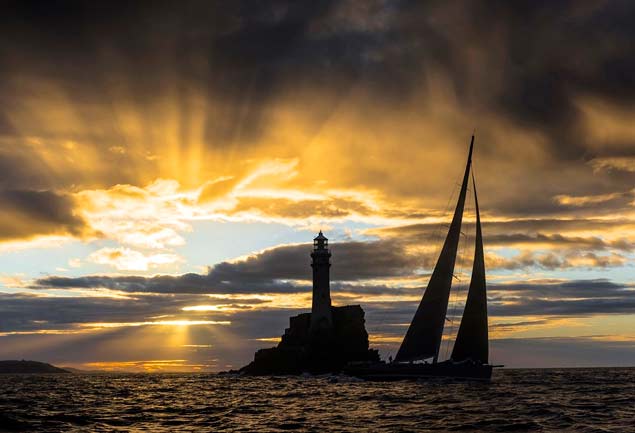 Glad morning again….the biggest boat in the race, the JV 115 Nikata (Tom Brewer) rounds the Fastnet Rock at 7 o’clock on Tuesday morning. Photo Rolex
Glad morning again….the biggest boat in the race, the JV 115 Nikata (Tom Brewer) rounds the Fastnet Rock at 7 o’clock on Tuesday morning. Photo Rolex
For after an increasingly rugged windward slug the whole way from the start, the overall leader at the Rock was 2013’s winner, the French JPK 10.10 Night & Day, whose achievement was further heightened by the fact that she was being sailed two-handed by father-and-son crew Pascal and Alexis Loison.
And second overall was another seasoned French campaigner, Noel Racine with his JPK 10.10 Foggy Dew. But it’s when we get to third slot that Irish eyes light up, as it was comfortably held by our own Paul Kavanagh’s Swan 44 Pomeroy Swan. She was all of 11 minutes ahead of yet another French boat, Giles Fournier’s J/133 Pintia, which was fourth overall at the Fastnet.
But close behind in sixth overall was the classic S&S 41 Winsome (Harry Hiejst) helmed by Laura Dillon, Irish Champion Helm in 1996. Winsome had experienced her ups and downs since the start, but when it comes to grown-up windward work, there are still very few boats that can do it like the best 1972 Sparkman & Stephens design, and Winsome had been making hay since Land’s End, marching her way up through the fleet.
However, before we move on to see how these leaders-at-the-Rock finally ended in the rankings in Plymouth, casting an eye further down the Fastnet times continues to be rewarding, as we find that the hot ISORA J/109 Mojito (Peter Dunlop and Vicky Cox) was lying 9th overall as she made the turn on Wednesday morning at 7 o’clock, and Kenneth Rumball in command of the Irish National Sailing School’s J/109 Jedi was only a quarter of an hour later, correcting into 11th overall, which put him one place ahead of our RORC Commodore Michael Boyd in the First 44.7 Lisa.
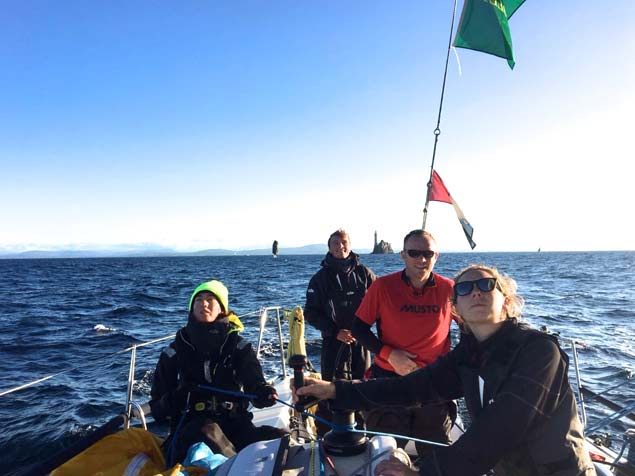 Cheerful times aboard Jedi after rounding the Fastnet, where she’d been placed 11th overall of the entire 312-strong IRC fleet. Photo INSS
Cheerful times aboard Jedi after rounding the Fastnet, where she’d been placed 11th overall of the entire 312-strong IRC fleet. Photo INSS
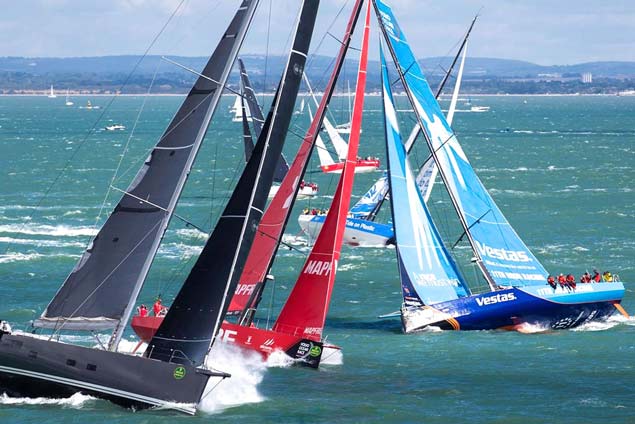 Nikata at the start with three of the Volvo 65s. The new Volvo boats had a very close Fastnet Race, with Dongfeng winning by 54 seconds from Mapfre. And they’re being kept busy – on Thursday they raced away from Plymouth, bound for St Malo and Lisbon
Nikata at the start with three of the Volvo 65s. The new Volvo boats had a very close Fastnet Race, with Dongfeng winning by 54 seconds from Mapfre. And they’re being kept busy – on Thursday they raced away from Plymouth, bound for St Malo and Lisbon
Yet of the boats which are now figuring at the top twelve of the overall leaderboard in Plymouth, only Pintia, Lisa and the Grand Soleil 43 Codiam were in the top twelve at the rock. The JNA 39 Lann Ael 2 (Didier Gaudoux), which seemed to come out of nowhere at the finish to snatch the overall lead from Ron O’Hanley’s Cookson 50 Privateer, was only 29th at the Fastnet Rock.
As for Privateer, she was well back, in 40th. Yet the way the winds, weather and tides developed for the final 247 miles from Fastnet to finish meant the placings continued to be shaken up until the very end, and it looked for long enough as though Privateer has the big prize until Lann Ael 2 came out of the dark in the small hours of Thursday morning, and took it.
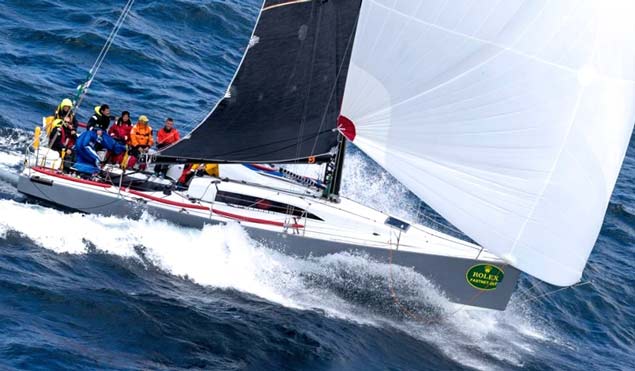 The JDA 39 Lann Ael making knots on the way to Plymouth
The JDA 39 Lann Ael making knots on the way to Plymouth
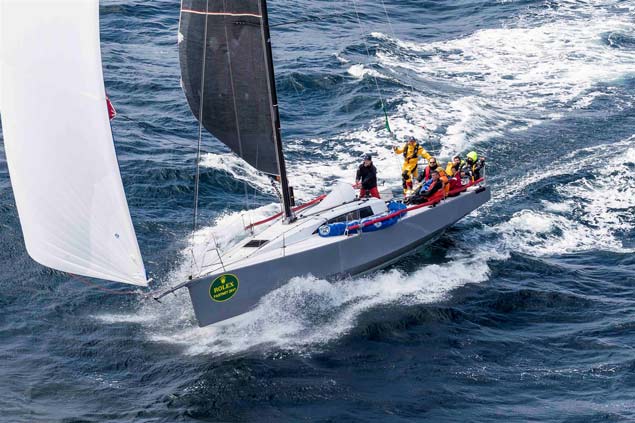 The look of a winner. Lann Ael was not showing up on the Race Tracker for some tehnical reason, but she was very definitely right there, zooming past the Isles of Scilly on her way to the overall win
The look of a winner. Lann Ael was not showing up on the Race Tracker for some tehnical reason, but she was very definitely right there, zooming past the Isles of Scilly on her way to the overall win
This means that for the third time in a row, the overall Rolex Fastnet Race winner is French. There’s no doubt about it, but La belle France is on a roll on the offshore scene these days, for if they aren’t themselves actually sailing the winning French-built boats, the chances are they were the designers and builders.
This is an impression which is reinforced by going into the class details, and particularly among the smaller boats. In IRC 3 it’s French-produced boats dominant, with two JPK 10.80s – Dream Pearls and Timeline - separated by just two minutes on corrected time, with Timeline having finished first, but losing through a higher rating.
It’s not until we got down to 9th place in IRC 3 that we break the French stream, and even here the 9th placed Irish J/109 Jedi – which wins IRC 3B - may have been designed in America by the Johnstone team, but I’ve a feeling she was built in France.
The placing means that Jedi got through Mojito in the sometimes wild romp back from the Rock, but all around them positions were changing, and the solid Sparkman & Stephens veterans such as Pomeroy Swan and Winsome, which had shown so well on the dead beat, were losing time all the way while the loghter boats were surfing.
However, while the two overall leaders at the Fastnet, Night & Day and Foggy Dew, slipped down the overall rankings, they maintained their class leads in IRC 4, and let it be noted that Poweroy Swan wasn’t entirely out of the hunt, as she is 4th in IRC 4. But Winsome slipped back to 12th in class.
It’s ironic that of the two former Champion Helms of Ireland whom we know to have been doing the Rolex Fastnet Race 2017, one of them – Laura Dillon – was in a boat which went superbly to windward but wasn’t so competitive downwind, while the other. Nin O’Leary, was in a boat which seemed woeful to windward, but was fastest of the lot as soon as she bore off at the rock.
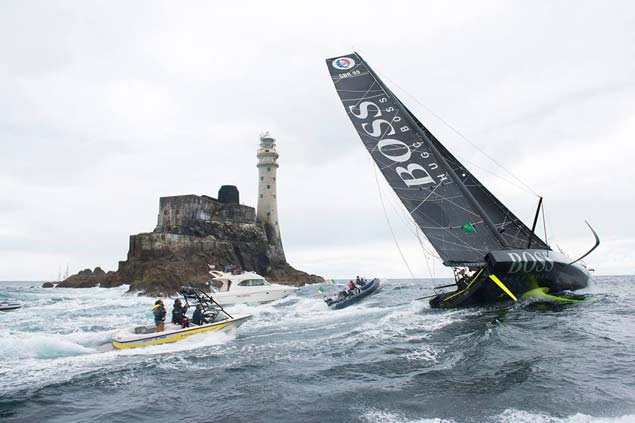 Hugo Boss finally reaches the Fastnet Rock at 3.0pm on Tuesday. Within minutes, she was speeding downwind, up on her foils and making 22 knots
Hugo Boss finally reaches the Fastnet Rock at 3.0pm on Tuesday. Within minutes, she was speeding downwind, up on her foils and making 22 knots
Quite why Nin’s co-skippered IMOCA 60 Hugo Boss was just so poor to windward, even by comparison with other IMOCA 60s, is something for further study. But she’s very much a boat for the wide open spaces, and the relatively short 247 miles from the Fastnet to Plymouth wasn’t nearly long enough for her foils to pick her up properly, and let the big black boat really go like the wind.
It was clearly a race of horses for courses, and while it might be going too far to describe Hugo Boss as a one trick pony, in a complex race like this there were some superb all-round boats which gave a master-class in successfully dealing with a wide variety of conditions and finishing with a mileage which suggested that some other boats were sailing a different race entirely.
 The Yacht Club de Monaco’s IMOCA 60 Malizia placed third in class
The Yacht Club de Monaco’s IMOCA 60 Malizia placed third in class
To re-phrase the great Damon Runyon, the race may not always be to those who sail the shortest distance, but that’s the way the smart money bets. However, the smart money isn’t always completely right. The Fastnet Race course is somewhere between 603 and 608 miles (those pesky Traffic Separation Zones must have changed the classic distance), and it’s of interest to note that the boat which was recorded as sailing the fewest miles, the Italian Mylius 15E25 Ars Una which placed 11th overall, got round in just 655 miles.
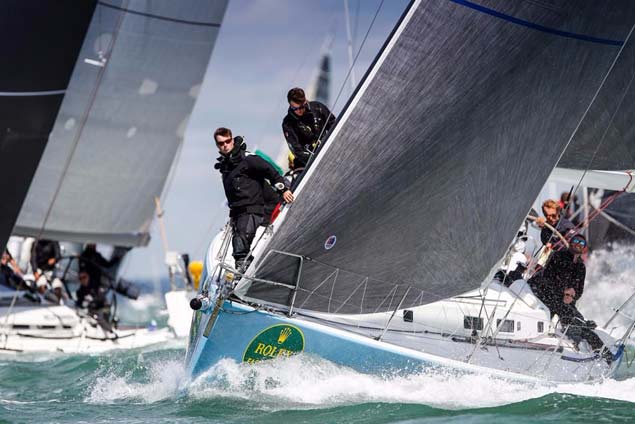 The French J/133 Pintia (Gilles Fournier) at the start. One of the most consistent boats in the fleet, she was well placed overall at the Fastnet, and went on to win Class 2 while placing fourth overall at the finish
The French J/133 Pintia (Gilles Fournier) at the start. One of the most consistent boats in the fleet, she was well placed overall at the Fastnet, and went on to win Class 2 while placing fourth overall at the finish
But Winsome, back in 75th overall after being so handsomely placed at the rock, got round in only 656 miles. She pointed higher than most other boats, and made the right tactical choices on the open water outward bound windward leg. But coming back on the fast run, her classic hull shape militated against her no matter how neat a course they sailed.
The detailed results are here
As for the winner Lann Ael 2, she sailed 662 miles, but for the Fastnet-Plymouth stages she had conditions which clearly suited her perfectly, while the Cookson 50 Privateer sailed all of 687 miles, but she sailed them so well she retained second overall. And the great pioneer, the pathfinder in the lead on the water and testing condtions for all those astern, was George David’s Rambler 88. She may have taken line honours in convincing style, but she sailed an astonishing 730 miles to do so, and slipped back to 65th overall when the basic sums were done.
These sums will be re-worked for a long time yet, for this was one very special Rolex Fastnet Race. Our own Michael Boyd captured it so perfectly in his role as Commodore RORC, shortly after he had finished to take second in class, that it’s worth re-running the vid we posted last night, for he did us proud.
Read all of Afloat.ie's 2017 Fastnet Race coverage here
'Phantom Boat' Rises Without Trace to Win Fastnet Race?
The harsh northwest to north wind that dominated the past three days of the Rolex Fastnet Race 2017 has softened its cough through Thursday. It’s settling in to be an Atlantic sou’west to west airflow, which eventually will bring rain over Ireland, but just for once there’s a chance it won’t rain in Plymouth writes W M Nixon.
That would be one for the books, as most of us recall the post-Fastnet celebrations as invariably involving the occasional deluge, but maybe climate change is for real. Whatever, the task of unravelling 312 IRC-rated results and getting everything set up for Friday night’s prize-giving is as hectic as ever. But at least the main man, RORC Commodore Michael Boyd, was comfortably finished well in time this morning (Thursday) in command of the First 44.7 Lisa, and he’ll have had a good night’s sleep before festivities begin tomorrow evening’s fiesta. During it, for the sake of ID, he is obliged to wear an old-fashioned white-topped yachting cap. You need to be well-rested and in the full of your health to do that with style and assurance.
As to the racing, he has put himself in place for the Gull Salver for the best-placed Irish boat by being an impressive 8th overall and second in Class 2 to Pintia after sailing a very neat race. Lisa had logged just 669 miles for a 605 mile course, in which some other boats thought there was an awful lot of slugging to windward, with many tacks and many more miles to be sailed. But Lisa, and others whose performance we hope to be examining in more detail in Saturday’s blog, managed to shimmy round with very few extra miles sailed - her skipper gives his impressions of the boat and the race here:
Few did the minimal miles more emphatically than the Phantom Boat, which really did come out of nowhere to win overall. The French JND 39 Lann Ael 2 (Didier Gaudoux) didn’t show up at all on the entry list attached to the Tracker Chart. And her position was never indicated on the Tracker Chart itself either. Yet suddenly on Wednesday, she rose without trace on the leaderboard, shown as having the potential to snatch the veteran Cookson 50 Privateer’s overall win at the last moment.
And that, in the small hours of this morning, is precisely what she did. The Phantom Boat sailed only 662 miles to get round the course whereas Privateer – which will surely hang onto her second place overall – sailed 687 miles. But Lann Ael 2 came out of the darkness off Plymouth at just after two o’clock this morning, and bested Privateer by a pretty convincing 42 minutes. Yet where she did it and how she did it, heaven only knows. She has been and gone without leaving so much as a shadow. However, tomorrow night her crew will wrap themselves round the very real Fastnet Trophy, so who cares whether they cast a shadow or not?
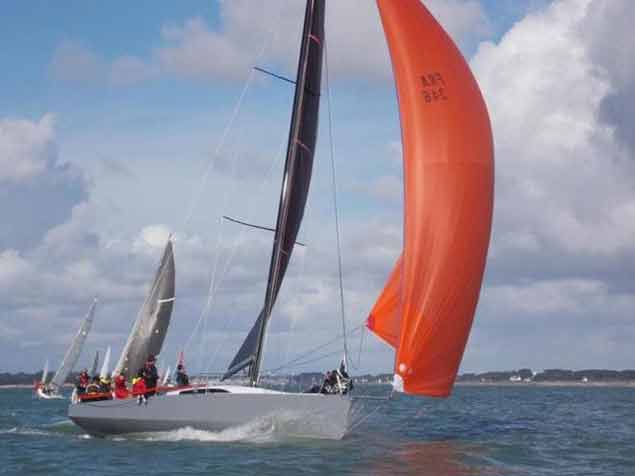 Is she leaving a shadow here? Lann Ael 2 in smoother conditions in the Solent.
Is she leaving a shadow here? Lann Ael 2 in smoother conditions in the Solent.
Certainly not the Irish or Irish-connected boats in or near the finish as we sign this off at 2030 hours Thursday. When this great race started, we were interested particularly in the two sailing school boats, the Irish National Sailing School’s J/109 Jedi, and Irish Offshore Sailing’s Sunfast 37 Desert Star, which won the Sailing School Trophy in 2015’s race.
Well, the Kenneth Rumball-skippered Jedi has had the best of it, finhshing tonght at 2100 hrs.. In fact, she’s done well every which way, as she also beat the Welsh/Irish J/109 Mojito (Peter Dunlop & Vicky Cox), although for the final hundred miles it was as though Jedi, Mojito and the classic S & S 41 Winsome, helmed by Laura Dillon, were glued together, so closely did they hold their relative positions.
Tracker here
But just who wins the Roger Justice Trophy for the best sailing school result won’t be known just yet, as the information as to which crew qualified as a sailing school appears to be kept under wraps. All will be revealed by tomorrow evening.
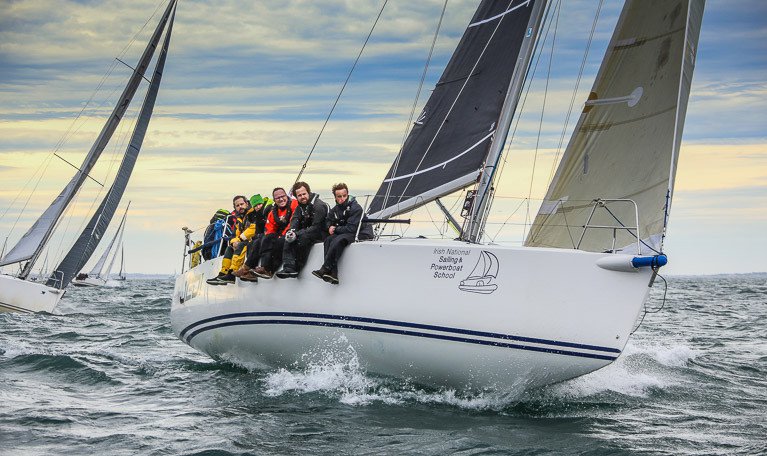 The Irish National Sailing School’s 29–year–old Kenneth Rumball–skippered J/109 Jedi has done best of the Irish sailing schools in the Fastnet Race, and has also managed to beat Mojito, one of the hottest J/109s in the Irish Sea.
The Irish National Sailing School’s 29–year–old Kenneth Rumball–skippered J/109 Jedi has done best of the Irish sailing schools in the Fastnet Race, and has also managed to beat Mojito, one of the hottest J/109s in the Irish Sea.
RORC Commodore Boyd Sails Home in Fastnet Race Top Ten
Overnight and into a magnificent West Country morning, boats have been streaming across the Rolex Fastnet Race finish line and into Plymouth Yacht Haven writes James Boyd. With this the leaders in the bigger classes have begun firming up along with the prospects for the boat will be the crowned overall winner under IRC in the Royal Ocean Racing Club's biennial flagship offshore race.
American Ron O'Hanley's Cookson 50, Privateer is the leader in the IRC Zero from the Ker 46 Lady Mariposa, and yesterday seemed to be in good shape to take the overall prize across the 312-boat IRC fleet vying for the Fastnet Challenge Cup. However overnight the IRC One leader Lann Ael 2, the JND 39 of Paris-based Didier Gaudoux pulled into the lead. In IRC One the powerful looking La Crouesty based boat holds a lead of more than two and a half hours on corrected time over the equally angular Lombard 46, Pata Negra, being campaigned by the Dutch de Graaf family of Baraka Ker 40 fame.
"We had a fantastic race - we were lucky with the weather," said Gaudoux. "The conditions were quite good for the team and the crew and the passage from Fastnet Rock to the Scilly Isles was perfect for us." However at present there are many smaller boats still capable of lifting the overall IRC prize off the IRC One leader.
Last night, first home on the water in IRC One was James Neville's Ino XXX, winner of May's Myth of Malham race. Like all of the planing boats, the HH42 enjoyed the downhill conditions enabling them to blast back from the Fastnet Rock, hitting speeds into the mid-20s and covering 75 miles in four hours. This made up for the headbang of an uphill struggle they experienced outbound to the Rock. As Neville recounted: "We found it quite challenging because the chop was quite short and the heavier boats, like the Italian boat [Vittorio Biscarini's magnificent Mylius-designed 50 footer, Ars Una], make better way in those conditions. Off the Lizard we went inside and they found more wind offshore. We were the last boat to go to the east of the TSS."
In IRC Two Gilles Fournier and Corinne Migraine's J/133 Pintia is looking good for first prize following their arrival at the finish line at 05:33 this morning.
"We had some good results already in IRC Two this year," said Fournier. "But the Rolex Fastnet Race is the peak of the season. We have had an internal battle with our friends on Lisa, including Commodore of the RORC Michael Boyd, since the beginning of the season."
Due to the tidal state at the time, Pintia went to the west of the all-important traffic separation scheme off the Scilly Isles. Fournier said he enjoyed rounding the Fastnet Rock, even though it was at night. "You are pleased when you round that because it is an amazing place. You wouldn't want to spend your holidays there, but it is a legendary place and we are now part of the legend."
Nick and Suzi Jones' First 44.7 Lisa, skippered by RORC Commodore Michael Boyd, finished 36 minutes after Pintia this time correcting out into second place, 1 hour 13 minutes behind of the French boat on corrected time.
Boyd acknowledged that Pintia had stolen a march on them at Portland Bill. "We failed to get to there in time. Pintia went in and we probably should have followed her and they just managed to get through the gap. We went outside and lost quite a few miles but we gained them back at Lyme Bay when an awful lot of boats went in and we were surprised to see some of our competitors at anchor there. We were further offshore, in the wind. That kept us up with the IRC One boats."
The boats in Lisa's group saw 25 knots on the nose, some of the strongest conditions crossing the Celtic Sea to the Fastnet Rock, requiring the crew to live on the rail. Boyd described the Fastnet Rock, off his native Ireland, as "extraordinary, absolutely magical". While the First 44.7 isn't a weapon downwind, the boat had a bowsprit and asymmetric spinnakers added to her Banks sail inventory for this season, aiding their return journey back from the Rock.
Lisa currently lies second in IRC Two and eighth overall under IRC, results with which Boyd was pleased. "I don't know if we had the best of the conditions, but certainly it is a great result and does seem to show that we were very favoured. But we had a great group of guys, everybody very focused, very good food, lots of stories and lots of laughs."
Michael Boyd, RORC Commodore and Skipper of Lisa spoke to Fastnet TV after docking in Plymouth
This afternoon the leaders in IRC Three and Four are due, along with the Two Handed class, where the Loisin father and son, Pascal and Alexis, on their 2013 overall Rolex Fastnet Race winning JPK 10.10 Night and Day have taken the lead from Ajeto!, the J/122e of Robin Verhoef and John Van Der Starre.



























